Winter in Massachusetts brings a unique sight to birdwatchers as various bird species migrate to seek refuge from colder regions. The state becomes a winter paradise for both amateur and experienced bird enthusiasts.
From the majestic Bald Eagle to the elusive Snowy Owl, Massachusetts offers a diverse range of winter birds that captivate and inspire.
This article will explore some of the remarkable feathery residents that grace the Bay State during the winter months, their behaviors, and where best to find them.
So, grab your binoculars and join us as we embark on a thrilling journey into the world of winter birds in Massachusetts.
49 Winter Birds In Massachusetts
If you are a bird lover, you might wonder what kinds of birds you can see in Massachusetts during the winter. The state is home to various winter birds, some of which are residents and some of which are visitors from colder regions.
Here are 49 winter birds in Massachusetts.
1. House Sparrow
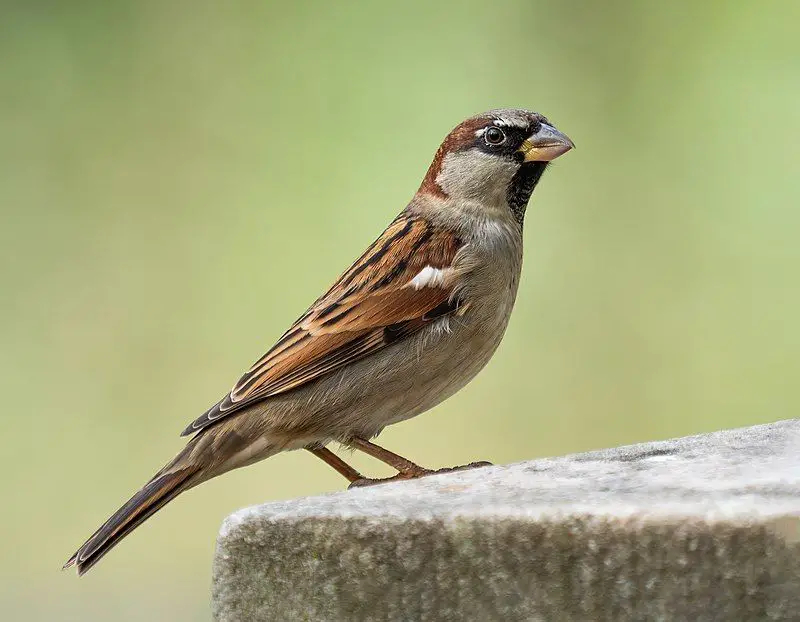
The house sparrow is a type of bird that belongs to the sparrow family called Passeridae. These birds can be found in many different parts of the world. They are pretty small, typically measuring about 16 cm in length.
In terms of weight, they usually range between 24 to 39.5 grams. Regarding their appearance, female and young house sparrows are generally colored in pale shades of brown and grey.
This coloration helps them blend in with their surroundings and provides them with some camouflage. On the other hand, male house sparrows have more vibrant colors.
They display black, white, and brown markings, making them easily distinguishable from the females and young birds.
The contrasting colors of the male house sparrows serve various purposes. Firstly, these colors help attract mates during the breeding season.
The brighter markings act as a visual signal to the females, indicating that the male is healthy and capable of providing for offspring.
These markings also play a role in defending territory and establishing dominance among other male sparrows. The house sparrow’s coloration is not only limited to their feathers. They also have distinct beak colors that differ between males and females.
| Kingdom | Animalia |
| Phylum | Chordata |
| Clade | Dinosauria |
| Class | Aves |
| Order | Passeriformes |
| Family | Passeridae |
| Genus | Passer |
| Species | P. domesticus |
2. Downy Woodpecker
The downy woodpecker is a type of bird known as a woodpecker. It is the smallest species of woodpecker found in North America.
Its size can range from 14 to 18 centimeters. These woodpeckers can be found in various forested areas across the United States and Canada.
However, they are not commonly seen in desert regions in the southwest or the northern tundra. Due to their small size, downy woodpeckers are well-adapted to living in forested environments.
They can navigate through the trees and search for food more quickly than larger woodpecker species. One exciting feature of the downy woodpecker is its ability to drum on trees.
This drumming serves multiple purposes, including communication with other woodpeckers and marking its territory. The diet of the downy woodpecker primarily consists of insects and larvae found within the trees.
They use their strong beaks to peck at the bark and wood, uncovering their prey. These woodpeckers are known for their distinct black and white plumage.
They have a white belly and back, with black wings and a black head. This coloration helps them blend in with the tree.
| Kingdom | Animalia |
| Phylum | Chordata |
| Clade | Dinosauria |
| Class | Aves |
| Order | Piciformes |
| Family | Picidae |
| Genus | Dryobates |
| Species | D. pubescens |
3. Woodpeckers
Woodpeckers belong to a bird family called Picidae. This family also includes other birds like piculets, wrynecks, and sapsuckers. Members of the Picidae family can be found all around the world, except in certain places.
Australia, New Guinea, New Zealand, Madagascar, and the extreme polar regions are where these birds are not found. Woodpeckers are unique birds known for their ability to peck and drum on trees.
They have specially adapted beaks and strong neck muscles that allow them repeatedlyto strike trees repeatedly.
This behavior is used for feeding, communication, and establishing territories. Piculets are smaller woodpecker-like birds that belong to the Picidae family.
They have similar physical characteristics and behaviors as woodpeckers, but they are usually smaller in size. Wrynecks, another member of the Picidae family, are small, insect-eating birds with long, slender bills.
They are known for their ability to twist their necks in a snake-like fashion. Sapsuckers, also part of the Picidae family, are woodpeckers wiswith unique feeding habits. They drill small holes in trees.
| Kingdom | Animalia |
| Phylum | Chordata |
| Clade | Dinosauria |
| Class | Aves |
| Order | Piciformes |
| Family | Picidae |
4. American Robin
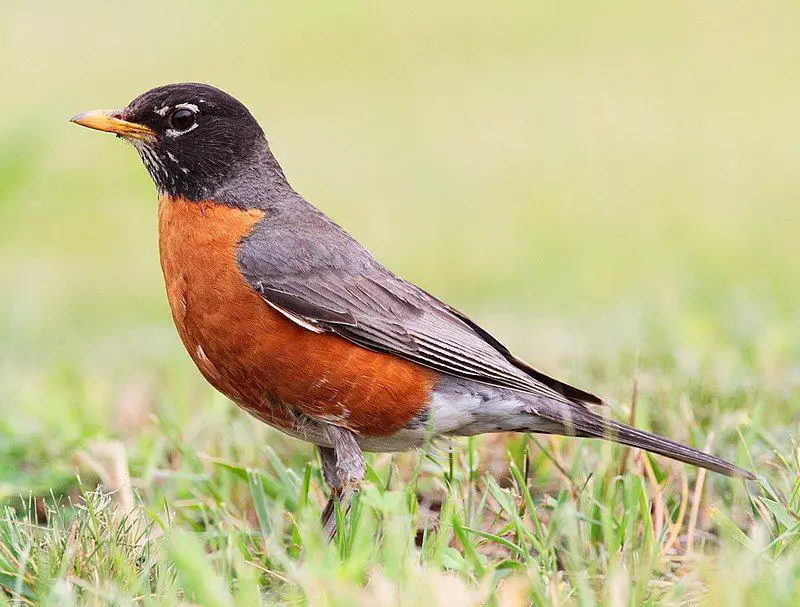
The American robin is a type of bird that migrates. It belongs to the valid thrush genus and the Turdidae family, a larger thrush familyets its name from the European robin because of its reddish-orange breast.
However, it is essential to note that the American robin and the European robin are not closely related. The European robin is a different species and belongs to the Old World flycatcher family.
Despite their similar names and physical characteristics, these two birds are not closely related regarding their genetic makeup.
They may share some similarities in appearance, such as the reddish-orange breast, but their evolutionary paths have taken them in different directions. The American robin is primarily found in North America, while the European robin is native to Europe and parts of Asia.
Both species have adapted to their respective environments and habitats over time.
The American robin is known for its ability to migrate long distances, often traveling south during winter and returning north for breeding season. Regarding physical characteristics, the American robin is larger than the European robin.
It has a grayish-brown back and a distinct reddish-orange breast, a defining feature of the species.
| Kingdom | Animalia |
| Phylum | Chordata |
| Clade | Dinosauria |
| Class | Aves |
| Order | Passeriformes |
| Family | Turdidae |
| Genus | Turdus |
| Species | T. migratorius |
5. Cardinalidae
Cardinalidae is a family of birds that are found only in the New World. This means that they are native to the Americas and are not found anywhere else in the world. The family comprises different species, including cardinals, grosbeaks, and buntings.
These birds are all part of the same family because they share similar characteristics and traits. Cardinals are perhaps the most well-known members of the Cardinalidae family. They are known for their vibrant red plumage, which is more prominent in the males than females.
Cardinals are often seen in backyards and gardens, feeding on seeds and insects. They have a distinct crest on their heads, which adds to their unique appearance. Grosbeaks are another type of bird that belongs to the Cardinalidae family.
They are named after their large, thick beaks, adapted for cracking open seeds and nuts. Grosbeaks come in various colors, including red, black, and yellow.
They are known for their beautiful songs and can be found in forests and woodlands across the Americas. Buntings are also part of the Cardinalidae family. They are small to medium-sized birds that are known for their colorful plumage.
| Kingdom | Animalia |
| Phylum | Chordata |
| Clade | Dinosauria |
| Class | Aves |
| Order | Passeriformes |
| Family | Cardinalidae |
6. Northern Cardinal
The northern cardinal is a type of bird commonly referred to by different names, such as redbird, common cardinal, red cardinal, or simply cardinal.
It belongs to the genus Cardinalis. The cardinal is primarily found in North America, particularly in regions such as the United States, Canada, and Mexico. It is known for its vibrant red plumage, which is more prominent in males than females.
The male cardinal has a distinctive crest on its head, while the female has a reddish tinge on its feathers. These birds are often observed in various habitats, including woodlands, gardens, and urban areas.
They are adaptable to different environments and can thrive in both rural and suburban settings.
Cardinals are also known for their beautiful songs, which are melodic and often used for communication and territorial marking. In terms of diet, the cardinal is omnivorous, meaning it eats various foods.
Its diet comprises seeds, fruits, insects, and occasionally small reptiles or amphibians.
They have a strong beak that allows them to easily crack open seeds and fruits. Cardinals engage in courtship rituals during the breeding season, which typically occurs in spring and early summer. The male cardinal displays its vibrant red plum.
| Kingdom | Animalia |
| Phylum | Chordata |
| Clade | Dinosauria |
| Class | Aves |
| Order | Passeriformes |
| Family | Cardinalidae |
| Genus | Cardinalis |
| Species | C. cardinalis |
7. Black-Capped Chickadee
The black-capped chickadee is a small songbird found in North America. It is known for its distinctive black cap and white cheeks.
This bird is not migratory, meaning it does not travel long distances during different seasons. The black-capped chickadee prefers to live in deciduous and mixed forests.
These types of forests provide the bird with the necessary habitat, such as trees and shrubs, where it builds its nests and finds food.
As a passerine bird, it belongs to the tit family, which is scientifically called Paridae. Interestingly, the black-capped chickadee holds special significance in certain regions.
It is the state bird of Massachusetts and Maine in the United States, symbolizing its importance to the local environment and culture.
Additionally, in Canada, specifically in the province of New Brunswick, it is recognized as the provincial bird. Overall, the black-capped chickadee is a small, nonmigratory songbird that can be found in North America.
It thrives in deciduous and mixed forests and belongs to the tit family. Its significance is acknowledged through its designation as the state bird in Massachusetts and Maine and the provincial bird of New Brunswick.
| Kingdom | Animalia |
| Phylum | Chordata |
| Clade | Dinosauria |
| Class | Aves |
| Order | Passeriformes |
| Family | Paridae |
| Genus | Poecile |
| Species | P. atricapillus |
8. American Goldfinch
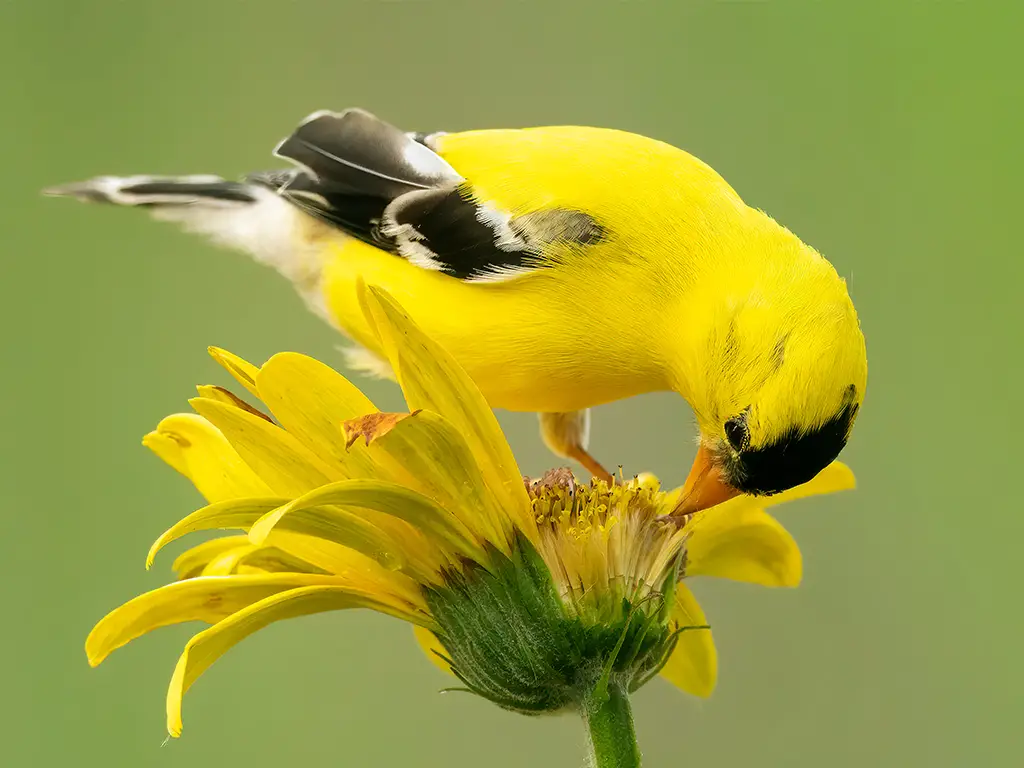
The American goldfinch is a type of bird found in North America.
It belongs to the finch family, a group of small birds known for their colorful feathers and pleasant songs. This bird is migratory, meaning it travels from one place to another depending on the time of year.
During the breeding season, when they mate and lay eggs, the American goldfinch can be found in areas ranging from mid-Alberta in Canada to North Carolina in the United States. When the weather gets colder in the winter, the American goldfinch migrates to a different region.
They move from just south of the Canada–United States border and travel down to Mexico.
This helps them find better conditions for survival as the temperature and food availability change with the seasons. The reason for their migration is mainly related to the availability of food.
During the breeding season, the American goldfinch feeds on insects and seeds from plants like sunflowers and thistles.
These food sources are abundant in the areas where they breed, providing them with the necessary nutrients for reproduction and raising their young. However, these insects and plants may not be readily available in their breeding grounds during the winter.
| Kingdom | Animalia |
| Phylum | Chordata |
| Clade | Dinosauria |
| Class | Aves |
| Order | Passeriformes |
| Family | Fringillidae |
| Genus | Spinus |
| Species | S. tristis |
9. Dark-Eyed Junco
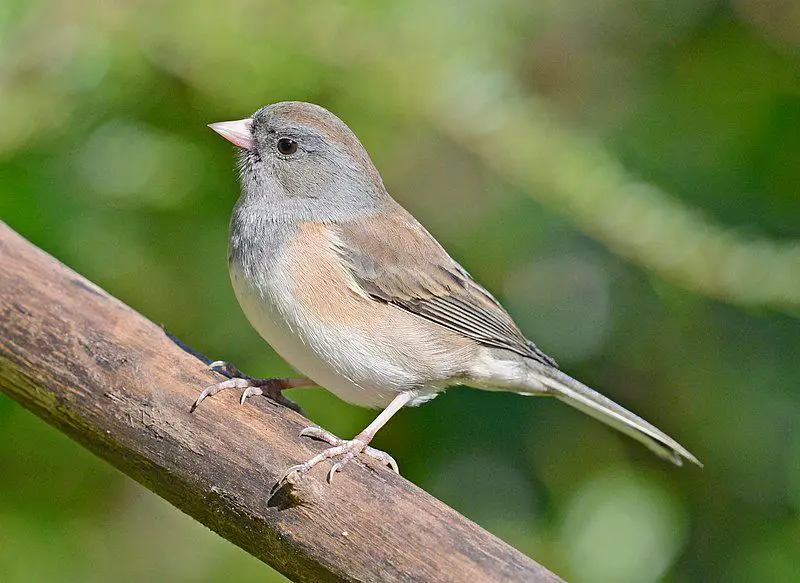
The dark-eyed junco is a type of bird called a junco. Juncos are small, grayish sparrows that live in the New World. The dark-eyed junco is found in many parts of temperate North America; during the summer, it even goes as far as the Arctic.
The dark-eyed junco is a species that has a lot of variation. This means that different individuals of this bird can look quite different from one another. It is similar to another species of sparrow called the fox sparrow in terms of its variability.
Despite being studied by scientists, the systematics of the dark-eyed junco are still not fully understood. Systematics refers to studying the relationships between different species and their classification.
So, even though researchers have been trying to figure out how the dark-eyed junco fits into the larger picture of bird species, there are still some unanswered questions.
| Kingdom | Animalia |
| Phylum | Chordata |
| Clade | Dinosauria |
| Class | Aves |
| Order | Passeriformes |
| Family | Passerellidae |
| Genus | Junco |
| Species | J. hyemalis |
10. White-Breasted Nuthatch
The white-breasted nuthatch is a type of bird that belongs to the nuthatch family called Sittidae.
This family includes various species of nuthatches, but we will focus on the white-breasted nuthatch in this discussion. The white-breasted nuthatch is considered a medium-sized bird, measuring around 15.5 cm in length.
This measurement gives us an idea of its size compared to other birds. While it may not be the most significant bird out there, it is also not the smallest. One exciting feature of the white-breasted nuthatch is its white breast, which gives it its name.
This white coloration on its chest stands out and helps to identify it from other species of nuthatches.
It is worth noting that not all nuthatches have this specific feature, making it unique to the white-breasted nuthatch. As a nuthatch family member, the white-breasted nuthatch shares specific characteristics with other nuthatch species.
For example, nuthatches are known for their ability to climb up and down trees headfirst. This behavior is quite fascinating to observe, as most birds can only move in an upward direction.
| Kingdom | Animalia |
| Phylum | Chordata |
| Clade | Dinosauria |
| Class | Aves |
| Order | Passeriformes |
| Family | Sittidae |
| Genus | Sitta |
| Species | S. carolinensis |
11. Tufted Titmouse
The tufted titmouse is a little bird found in North America. It belongs to the tit and chickadee family, which means it is closely related to other birds in that family.
In the past, another bird called the black-crested titmouse was thought to be a subspecies of the tufted titmouse. This means they were very similar in appearance and behavior but slightly different.
However, scientists have now determined that the black-crested titmouse is a separate species. It is officially called Baeolophus atricristatus. The black-crested titmouse is found in central and southern Texas, extending southward from there.
This means it can also be seen in areas further south from Texas. This separation of the black-crested titmouse from the tufted titmouse is an essential distinction in the scientific world.
It helps us understand the diversity of bird species and how they are related. Learning about these small songbirds and the distinctions between different species is fascinating.
Scientists can gain valuable insights into the natural world and the incredible by studying and understanding these differences.
| Kingdom | Animalia |
| Phylum | Chordata |
| Clade | Dinosauria |
| Class | Aves |
| Order | Passeriformes |
| Family | Paridae |
| Genus | Baeolophus |
| Species | B. bicolor |
12. Red-bellied woodpecker
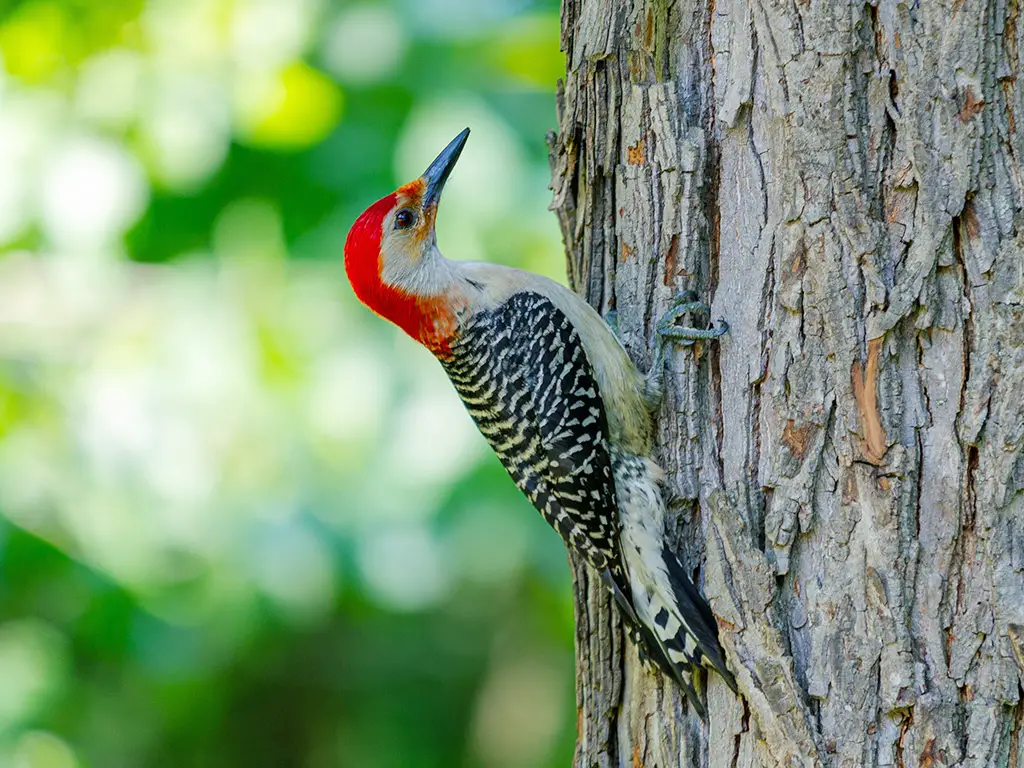
The red-bellied woodpecker is a bird that belongs to the family Picidae. It is not too big or too small; it is considered a medium-sized woodpecker.
This means it is smaller than some other woodpecker species but more significant than others. These woodpeckers are found primarily in the eastern part of the United States. However, they can also be seen in other areas.
They have a wide range, stretching from as far south as Florida to as far north as Canada. This means that they can be found in many different states and provinces within these regions. Regarding their appearance, the red-bellied woodpecker has some distinct features.
As the name suggests, they have a red belly, although this may not be immediately noticeable. Their belly is more of a pale or dull red color compared to other parts of their body.
They also have a red cap on the top of their head, which is more vibrant and noticeable. In addition to their red belly and cap, these woodpeckers have a black and white pattern on their back, wings, and tail.
The black feathers provide a nice contrast against the white feathers, creating a visual.
| Kingdom | Animalia |
| Phylum | Chordata |
| Clade | Dinosauria |
| Class | Aves |
| Order | Piciformes |
| Family | Picidae |
| Genus | Melanerpes |
| Species | M. carolinus |
13. Mourning Dove
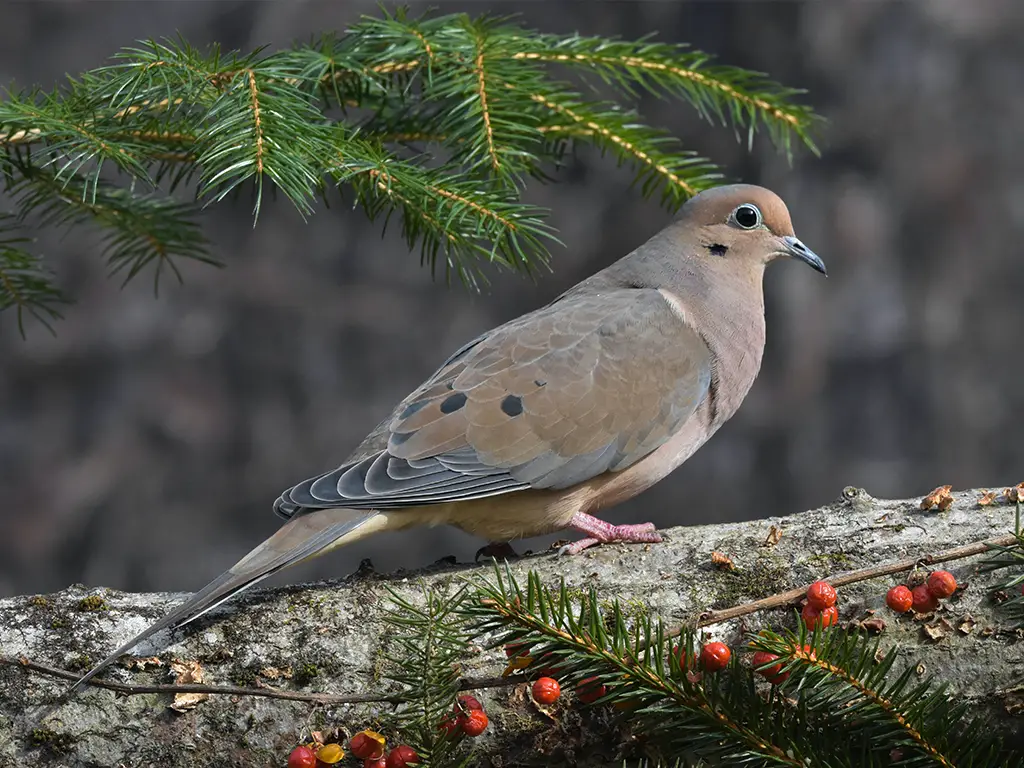
The mourning dove is a type of bird that belongs to the dove family called Columbidae. This bird is also known by different names,, such as the American mourning dove, the rain dove, colloquially the,,e turtle dove.
In the past, it was referred to as the Carolina pigeon and Carolina turtledove. The mourning dove is a common species found in North and Central America. It is recognized for its soft, mournful cooing sound, which gives it its name.
This bird is known for its slender body and long, pointed tail. It has a grayish-brown color with lighter shades on its underparts. One interesting fact about mourning doves is their ability to adapt to various habitats.
They can be found in different environments like forests, fields, urban areas, and deserts. They are known to thrive in both rural and suburban settings. Mourning doves primarily feed on seeds, grains, and fruits.
They have a unique diet as they can swallow seeds whole and store them in their crop, a specialized part of their digestive system. This allows them to eat in one location and then retreat to a safer place to digest their food. These birds are monogamous, meaning they mate.
| Kingdom | Animalia |
| Phylum | Chordata |
| Clade | Dinosauria |
| Class | Aves |
| Order | Columbiformes |
| Family | Columbidae |
| Genus | Zenaida |
| Species | Z. macroura |
14. Eastern Bluebird
The eastern bluebird is a type of bird native to North America. It is known for its ability to migrate or travel from one place to another.
It prefers to live in open woodlands, farmlands, orchards with plenty of trees and open spaces. One notable feature of the eastern bluebird is its bright blue breeding plumage.
The male bluebird has this vibrant blue color on its feathers during the breeding season. This makes it easy to spot and observe when perched on a wire or in an open area.
Many birdwatchers, also known as birders, find the eastern bluebird a favorite species to observe because of its striking appearance. The blue color of the male bluebird’s feathers is often associated with the breeding season.
It is a way for the male to attract a mate and signal its readiness to reproduce.
The bright plumage acts as a visual cue for potential mates, indicating that the male is healthy and capable of producing offspring. In addition to its blue feathers, the eastern bluebird has other distinctive physical characteristics.
It iis smaller than other birds, allowing it to maneuver easily in its woodland and farmland habitats.
| Kingdom | Animalia |
| Phylum | Chordata |
| Clade | Dinosauria |
| Class | Aves |
| Order | Passeriformes |
| Family | Turdidae |
| Genus | Sialia |
| Species | S. sialis |
15. Blue Jay
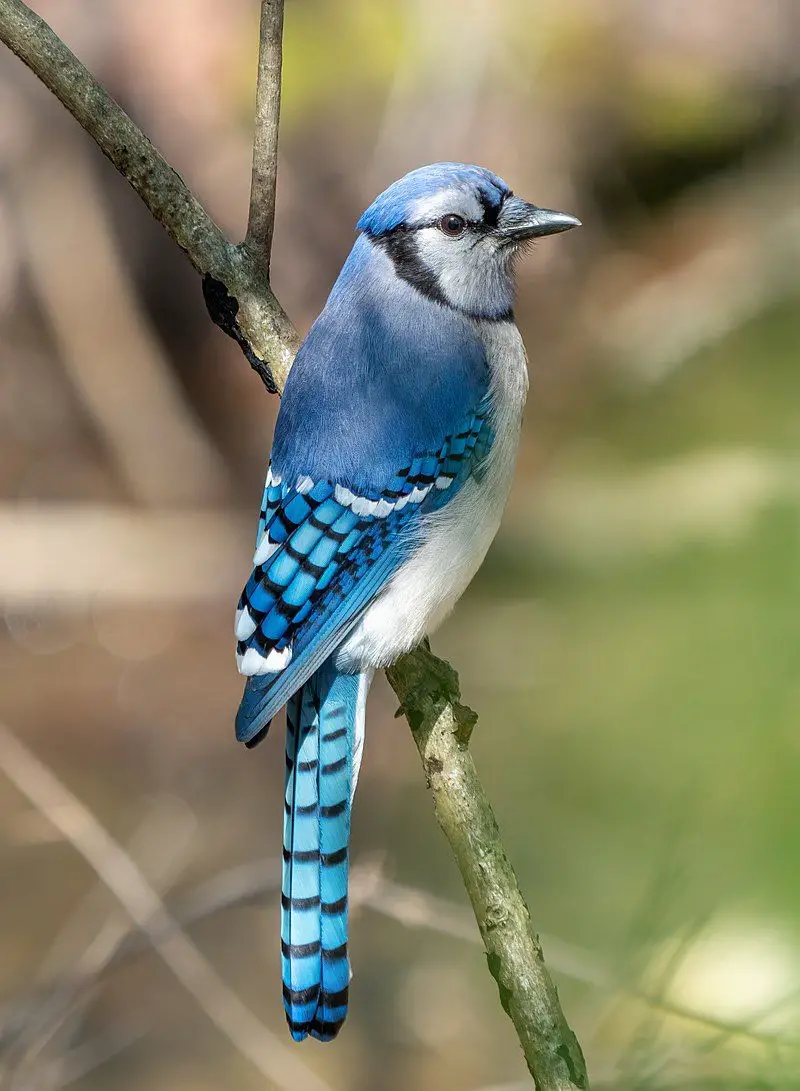
The blue jay is a bird that belongs to the family Corvidae. It can be found in eastern North America. This bird is commonly found in many eastern and central United States parts.
However, it is essential to note that some blue jays in the eastern regions may migrate to other areas. In addition to the United States, blue jays reside in Newfoundland, Canada. They are considered residents in this area.
Breeding populations of blue jays can be observed across southern Canada. This means that these birds reproduce and raise their young in this region. The blue jay is a passerine bird, meaning it has specialized feet that allow it to perch on tree branches.
It is native to eastern North America and can be found in various parts of the United States, Newfoundland, and southern Canada.
| Kingdom | Animalia |
| Phylum | Chordata |
| Clade | Dinosauria |
| Class | Aves |
| Order | Passeriformes |
| Family | Corvidae |
| Genus | Cyanocitta |
| Species | C. cristata |
16. House Finch
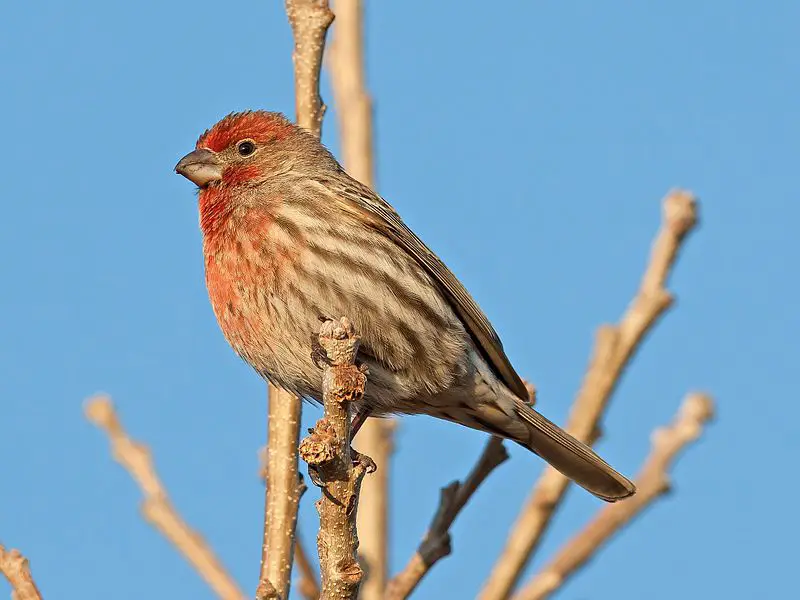
The house finch is a type of bird that belongs to the finch family called Fringillidae. This bird is originally from western North America.
However, it has also been introduced to other parts of the continent, such as the eastern half and Hawaii. The house finch is not the only bird in its genus.
It is grouped with two other American rosefinches, and all three are placed in the genus Haemorhous. The house finch is known for its beautiful red coloration, especially in males. The males have a reddish hue on their heads, chests, and backs.
Females, on the other hand, have more muted colors with brownish feathers. These birds are relatively small in size, measuring about 12 to 16 centimeters in length. They have short wings and a slightly notched tail.
Their beaks are conical in shape and and designed for cracking open seeds, which are their primary food food source. House finches are highly adaptable and can be found in various habitats, including urban areas, forests, and grasslands.
They are known for their melodic songs, which they use to communicate and attract mates. Breeding season for these.
| Kingdom | Animalia |
| Phylum | Chordata |
| Clade | Dinosauria |
| Class | Aves |
| Order | Passeriformes |
| Family | Fringillidae |
| Genus | Haemorhous |
| Species | H. mexicanus |
17. Red-Winged Blackbird
The red-winged blackbird is a type of bird that belongs to the passerine family called Icteridae.
It is commonly found in various parts of North America and a significant portion of Central America. Passerines are a diverse group of birds known for their musical and complex songs.
They have specialized vocal organs that produce a wide range of sounds. The red-winged blackbird is easily recognizable due to its distinct appearance.
The male red-winged blackbird has glossy black plumage and bright red patches on its wings, which give it its name.
On the other hand, the female red-winged blackbird has a more subdued appearance with brown feathers and streaks. These birds have a unique habitat preference, as they are commonly found in wetlands, marshes, and areas with tall grasses.
They are skilled at perching on tall plants and reeds, where they can easily spot their prey and potential predators. Red-winged blackbirds primarily feed on insects, seeds, and grains. They use their sharp beaks to catch insects on the fly and extract seeds from plants.
During the breeding season, they may consume small vertebrates such as frogs and tadpoles.
| Kingdom | Animalia |
| Phylum | Chordata |
| Clade | Dinosauria |
| Class | Aves |
| Order | Passeriformes |
| Family | Icteridae |
| Genus | Agelaius |
| Species | A. phoeniceus |
18. Common Starling
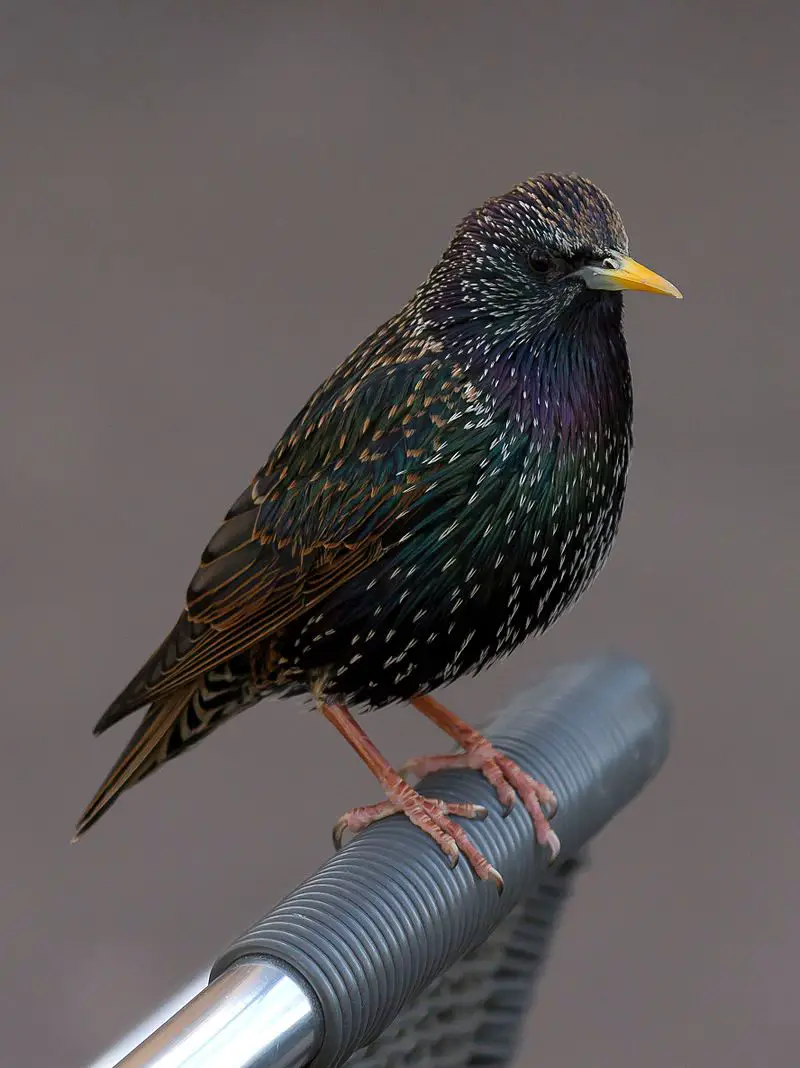
The common starling is a type of bird found in various regions. Depending on the location, it is referred to by different names. It is known as the European starling in North America, while in Great Britain and Ireland, it is simply called the starling.
This bird belongs to the starling family, scientifically known as Sturnidae. The common starling is classified as a passerine bird with its medium-sized build. Passerine birds are characterized by having feet adapted for perching, and they make up the most significant order of birds.
The starling family, to which the common starling belongs, is known for its diverse species worldwide. The common starling is known for its unique features and behaviors. It has a sleek and shiny black plumage with speckled spots, which gives it a distinct appearance.
The bird’s feathers can also appear iridescent in certain lighting conditions, showcasing shades of green and purple. One of the remarkable aspects of the common starling is its ability to mimic sounds and voices.
It has a wide range of vocalizations and can imitate various sounds in its environment, including other bird calls, human speech, and even mechanical noises.
| Kingdom | Animalia |
| Phylum | Chordata |
| Clade | Dinosauria |
| Class | Aves |
| Order | Passeriformes |
| Family | Sturnidae |
| Genus | Sturnus |
| Species | S. vulgaris |
19. Carolina Wren
The Carolina wren is a type of wren bird found in several regions. It is considered a common species, frequently seen in these areas. The bird is mainly found in the eastern half of the United States of America.
This includes states like North Carolina, South Carolina, and Virginia. However, it can also be spotted in other states within this region. Apart from the United States, the Carolina wren is also seen in certain parts of Canada.
Specifically, it can be found in the extreme south of Ontario. This means it is only present in the southernmost part of the province.
This is interesting because the bird’s range extends beyond the borders of the United States. Additionally, the Carolina wren can be observed in the extreme northeast of Mexico.
This means it is found in the northeastern part of the country, close to the border it shares with the United States.
This further highlights the bird’s ability to inhabit different regions within North America. The Carolina wren is a resident bird in the eastern half of the United States, the extreme south of Ontario, Canada, and the extreme northeast of Mexico.
It is a common species, often seen in these areas. Its range includes several states.
| Kingdom | Animalia |
| Phylum | Chordata |
| Clade | Dinosauria |
| Class | Aves |
| Order | Passeriformes |
| Family | Troglodytidae |
| Genus | Thryothorus |
| Species | T. ludovicianus |
20. White-Throated Sparrow
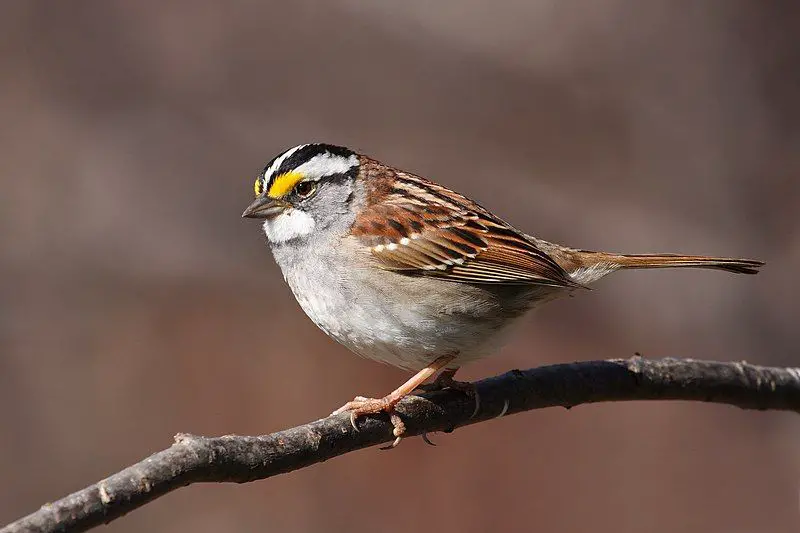
The white-throated sparrow is a type of bird that belongs to the passerine family called Passerellidae. This family of birds is commonly known as New World sparrows. Passerines are a diverse group of birds that make up more than half of all bird species.
They are known for their unique ability to perch and grip onto branches with their feet. The white-throated sparrow is easily distinguished by the white patch on its throat. This feature gives the bird its name.
These sparrows are native to North America and can be found throughout the continent, from Canada to Mexico. They are migratory birds, meaning they travel long distances during certain times of the year.
During the breeding season, white-throated sparrows are known for their distinct song, which can be described as a whistling “Oh sweet Canada, Canada, Canada.” This song helps them attract mates and establish their territory.
White-throated sparrows are relatively small birds, measuring about 6 to 7 inches long. They have a plump body with a rounded head and a short tail. Their plumage consists of a combination of gray, brown, and black feathers.
| Kingdom | Animalia |
| Phylum | Chordata |
| Clade | Dinosauria |
| Class | Aves |
| Order | Passeriformes |
| Family | Passerellidae |
| Genus | Zonotrichia |
| Species | Z. albicollis |
21. American Tree Sparrow
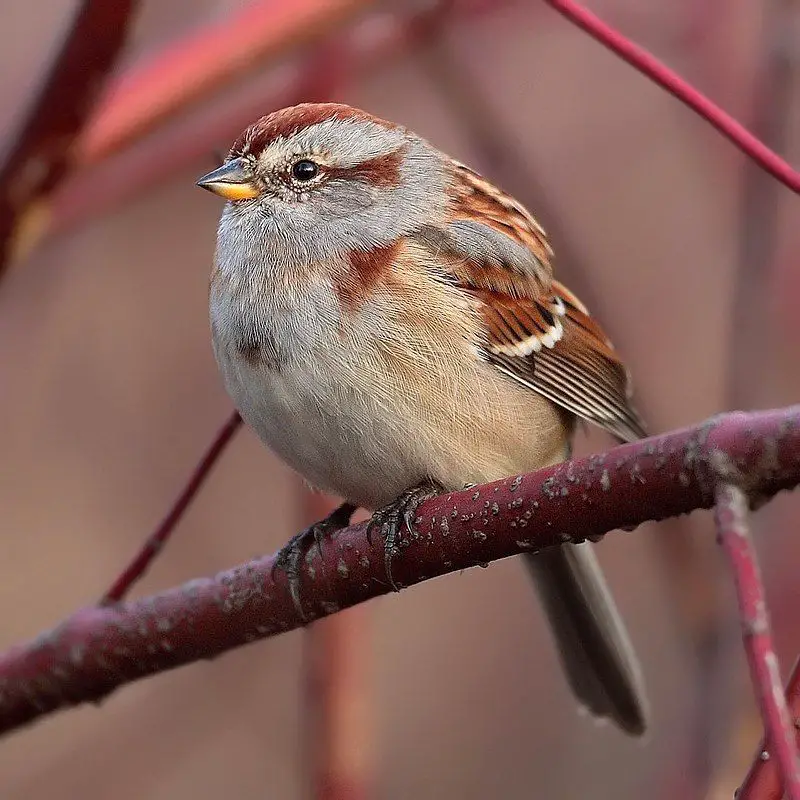
The American tree sparrow is a type of bird that is commonly found in North America. It is also known by another name, which is the winter sparrow.
This bird is medium size compared to other sparrows in the New World. The American tree sparrow is easily recognizable due to its distinct physical features. It has a plump body with a rounded head and a short tail. Its beak is cone-shaped and designed for eating seeds.
The bird’s plumage is mostly brown and gray, with a white belly and a chestnut-colored cap on its head. During the winter, the American tree sparrow migrates from its breeding grounds in the Arctic tundra to more southern regions of North America.
It seeks out habitats such as forests, thickets, and shrubby areas. This bird prefers to perch on branches rather than hopping on the ground like some other species of sparrows. In terms of diet, the American tree sparrow primarily feeds on seeds.
It prefers seeds from grasses, weeds, and various plants. It uses its beak to crack open the seeds’ hard shells, allowing it to access the nutritious interior. The breeding season for the American tree sparrow occurs during the summer.
| Kingdom | Animalia |
| Phylum | Chordata |
| Clade | Dinosauria |
| Class | Aves |
| Order | Passeriformes |
| Family | Passerellidae |
| Genus | Spizelloides |
| Species | S. arborea |
22. Song Sparrow
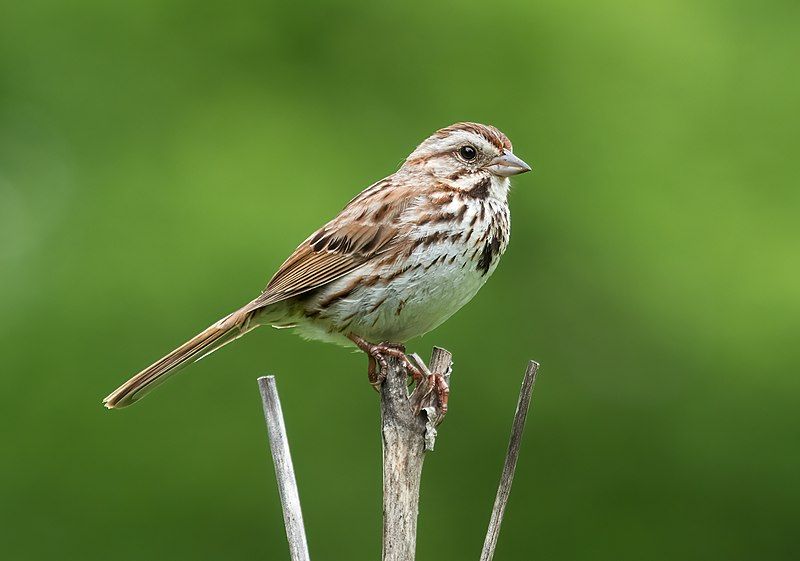
The song sparrow is a type of sparrow found in North America. It is considered to be medium-sized in comparison to other sparrows. Out of all the sparrows native to North America, the song sparrow is known to be one of the most abundant species.
This means that there are a large number of song sparrows in the wild. Not only is the song sparrow abundant, but it is also quite variable. This means that there can be different variations or types of song sparrows. They may have slight differences in appearance or behavior.
In addition to being abundant and variable, the song sparrow is also adaptable. This means that it can adjust well to different environments and conditions. It can thrive in various habitats, such as grasslands, marshes, and even urban areas.
The adaptability of the song sparrow allows it to have a wide range of distribution. It can be found in many parts of North America, from Canada to Mexico. Overall, the song sparrow is a fascinating medium-sized, abundant, variable, and adaptable bird.
Its ability to adapt to different environments has contributed to its success as a species in North America.
| Kingdom | Animalia |
| Phylum | Chordata |
| Clade | Dinosauria |
| Class | Aves |
| Order | Passeriformes |
| Family | Passerellidae |
| Genus | Melospiza |
| Species | M. melodia |
23. Northern Mockingbird
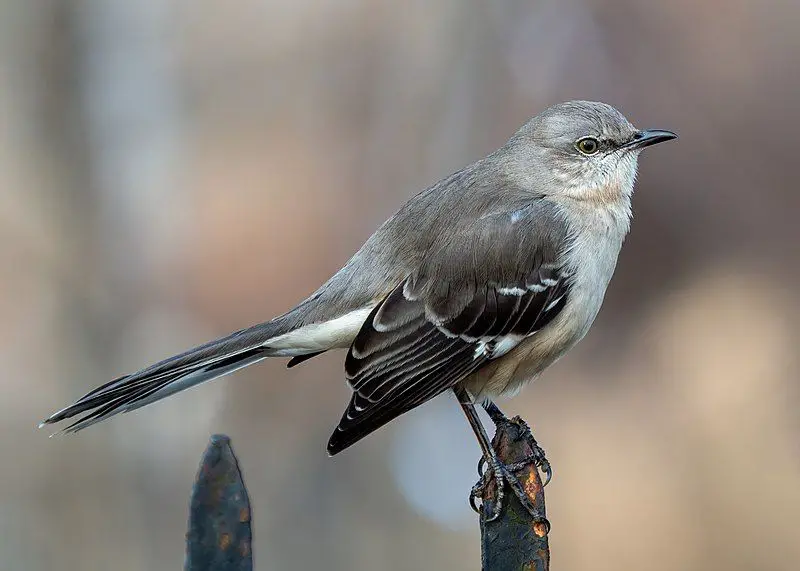
The northern mockingbird is a type of bird that is commonly found in North America. It is known for its ability to mimic the songs of other birds and even sounds from its environment.
This bird is typically seen throughout the year in North America, as it is a permanent resident in the region. However, during extreme weather, such as harsh winters, some northern mockingbirds may decide to migrate south in search of more favorable conditions.
This migration is not shared and only occurs when the weather becomes too challenging for these birds to handle. Despite being primarily found in North America, the northern mockingbird has been occasionally observed in Europe.
However, such sightings are rare, and this species is not considered a regular visitor to the European continent. It is interesting to note the adaptability of the northern mockingbird in terms of its ability to survive in different environments.
While it is mainly found in North America, it can move to more suitable locations during times of adversity. The northern mockingbird’s ability to mimic sounds is a unique characteristic that sets it apart from other bird species.
This skill allows it to imitate the songs of various birds and sounds like car alarms, sirens, or even human speech.
| Kingdom | Animalia |
| Phylum | Chordata |
| Clade | Dinosauria |
| Class | Aves |
| Order | Passeriformes |
| Family | Mimidae |
| Genus | Mimus |
| Species | M. polyglottos |
24. Mallard
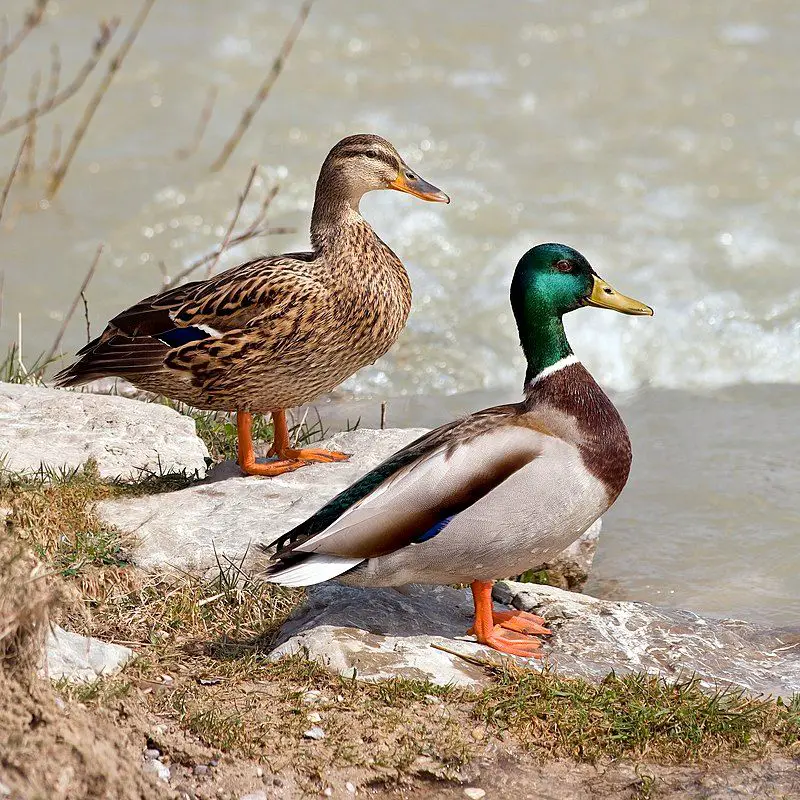
The mallard, also known as the wild duck, is a dabbling duck. It can be found breeding in various world world regions, including the temperate and subtropical Americas, Eurasia, and North Africa.
This duck species has been introduced to several countries outside its native range. For example, mallards have been brought to New Zealand, Australia, Peru, Brazil, Uruguay, Argentina, Chile, Colombia, the Falkland Islands, and South Africa.
The mallard’s ability to adapt to different environments has allowed it to thrive in these introduced regions. It is a versatile bird that can adapt to various habitats, such as wetlands, ponds, lakes, and even urban areas. In its native range, the mallard is a migratory bird.
However, in some introduced areas, it has become resident, meaning it stays in one place throughout the year rather than undertaking long-distance migrations.
The mallard is known for its vibrant plumage, with males having a distinctive green head, yellow bill, and brownish body. Conversely, females have a mottled brown appearance, which helps them camouflage with their surroundings. As dabbling ducks, mallards feed.
| Kingdom | Animalia |
| Phylum | Chordata |
| Clade | Dinosauria |
| Class | Aves |
| Order | Anseriformes |
| Family | Anatidae |
| Genus | Anas |
| Species | A. platyrhynchos |
25. Wrens
Wrens are a type of bird that belongs to the family Troglodytidae. They are mainly found in the New World, which includes the Americas.
There are about 88 species of wrens, and they are categorized into 19 different genera, which is a higher taxonomic rank. Interestingly, only one species of wren, called the Eurasian wren, that can be found in the Old World.
The Old World refers to regions such as Europe, Asia, and Africa. In English-speaking countries, this particular wren is called just “wren.”This is because the Eurasian wren is believed to be the original wren species that gave rise to the name.
Over time, as people encountered different species of wrens in the New World, they started using more specific names to differentiate them.
However, the name “wren” stuck with the Eurasian species because it was discovered and named first. So, when people in Anglophone regions say “wren,” they are usually referring to the Eurasian wren.
It is essential to note that this is a regional naming convention and may not be accurate in other languages or parts of the world.
| Kingdom | Animalia |
| Phylum | Chordata |
| Clade | Dinosauria |
| Class | Aves |
| Order | Passeriformes |
| Family | Troglodytidae |
26. Hermit Thrush
The hermit thrush is a type of bird found in North America. It is considered to be a medium-sized bird.
Interestingly, despite being a North American species, the hermit thrush is not closely related to other migratory birds in the area belonging to the Catharus genus. Instead, it is more closely related to the Mexican russet nightingale-thrush bird.
The hermit thrush is known for its specific name, “guttatus.” This name comes from the Latin language and means “spotted.” This is because the bird has spots on its body, a distinguishing characteristic.
In summary, the hermit thrush is a medium-sized bird found in North America. It is not closely related to other North American migrant species of the Catharus genus but rather to the Mexican russet nightingale-thrush.
Its specific name, guttatus, means “spotted” in Latin, referring to the spots on its body.
| Kingdom | Animalia |
| Phylum | Chordata |
| Clade | Dinosauria |
| Class | Aves |
| Order | Passeriformes |
| Family | Turdidae |
| Genus | Catharus |
| Species | C. guttatus |
27. Cedar Waxwing
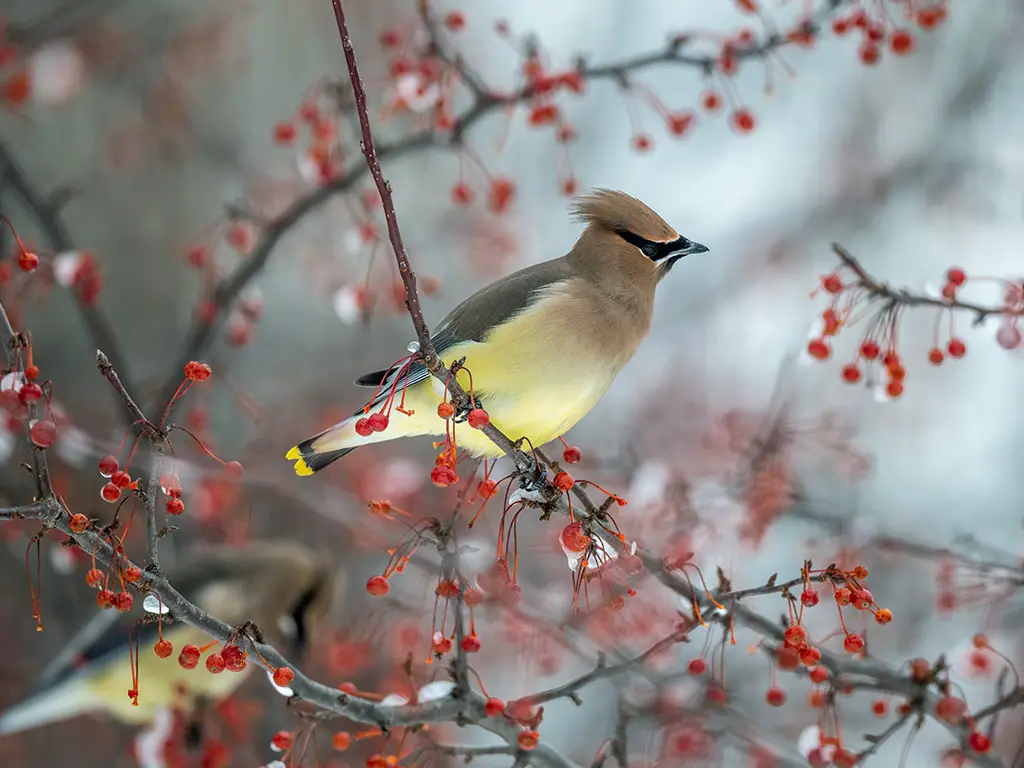
The cedar waxwing is a type of bird that belongs to the waxwing family of passerine birds known as Bombycillidae. Passerine birds are perching birds, which means they have feet adapted for gripping branches.
The cedar waxwing is a medium-sized bird with a distinctive appearance. Its feathers are mostly brown, gray, and yellow.
These colors help the bird blend well with its surroundings, making it harder for predators to spot it. One of the most unique features of the cedar waxwing is its wings. The bird gets its name from the wax-like tips on its wings.
These wing tips look like they have been dipped in wax, giving the bird a fascinating and memorable look. The wax-like wing tips serve a purpose for the cedar waxwing. They are specialized feathers that help the bird in various ways.
The waxy substance on the wing tips repels water, allowing the bird to fly more easily in wet weather conditions. It also helps the bird glide smoothly, reducing air resistance. Another exciting aspect of the cedar waxwing is its diet.
This bird primarily feeds on fruits like berries and small fruits, like cherries. It has a unique adaptation in it.
| Kingdom | Animalia |
| Phylum | Chordata |
| Clade | Dinosauria |
| Class | Aves |
| Order | Passeriformes |
| Family | Bombycillidae |
| Genus | Bombycilla |
| Species | B. cedrorum |
28. Canada Goose
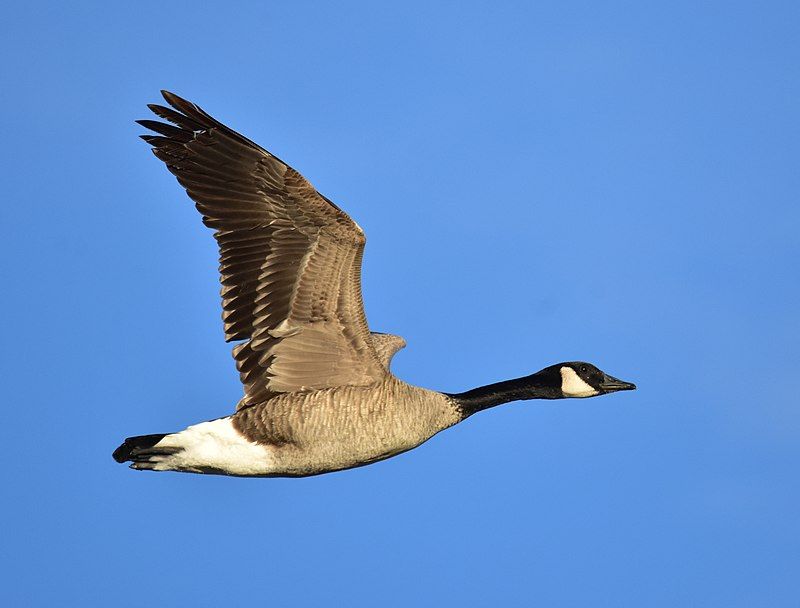
The Canada goose is a type of wild goose that can also be referred to as the Canadian goose. It is pretty large and has distinct physical features. One of its notable characteristics is a black head and neck.
Additionally, it has white cheeks and a white area under its chin. The body of the Canada goose is typically brown. This goose goose species is originally from the arctic and temperate regions of North America. It is well-adapted to these colder climates.
However, during migration, the Canada goose has been known to travel across the Atlantic and can occasionally be found in northern Europe. The Canada goose is a fascinating bird that has captured the attention of many due to its unique appearance.
Its black head and neck sharplycontrast sharply against its white cheeks and chin.
This distinctive coloration helps to identify the Canada goose from other species easily. Native to North America’s arctic and temperate regions, the Canada goose has evolved to survive in harsh environments.
Its adaptations to cold climates include a sturdy build and insulating feathers.
These features enable the goose to endure freezing temperatures and harsh weather conditions. Although primarily found in North America, the Canada goose displays an exciting behavior during migration.
| Kingdom | Animalia |
| Phylum | Chordata |
| Clade | Dinosauria |
| Class | Aves |
| Order | Anseriformes |
| Family | Anatidae |
| Genus | Branta |
| Species | B. canadensis |
29. Great Black-Backed Gull
The great black-backed gull is a species of gull that belongs to the most prominent member of the gull family.
It is known for its impressive size and has been described by the Cornell Lab of Ornithology as “the king of the Atlantic waterfront.”
This suggests that it is dominant among other birds in its habitat. One notable characteristic of the great black-backed gull is its aggressive hunting behavior.
It is a skilled and determined predator that actively seeks out its prey. This bird does not hesitate to confront other animals or even steal food from them.
It can be considered a formidable and effective hunter. In addition to hunting, the great black-backed gull is also referred to as a “pirate.” This term describes its behavior of stealing food from other birds or animals.
It does not hesitate to snatch away a meal, even if it means taking it from a weaker or smaller species. This opportunistic behavior helps the gull in securing its sustenance. Furthermore, the great black-backed gull is a proficient scavenger.
It has developed a knack for finding and consuming carrion or discarded food. This adaptive behavior allows the gull to survive in various environments and utilize available food sources.
| Kingdom | Animalia |
| Phylum | Chordata |
| Clade | Dinosauria |
| Class | Aves |
| Order | Charadriiformes |
| Family | Laridae |
| Genus | Larus |
| Species | L. marinus |
30. Ruby-throated hummingbirds
Archilochus is a type of hummingbird. This genus includes two species of small migratory birds. These birds have a unique behavior of traveling from one place to another during specific times of the year. The Archilochus hummingbirds breed in North America.
They choose their breeding grounds in this region to lay their eggs and raise their young. During the winter season, these Archilochus hummingbirds migrate to different locations.
They leave their breeding grounds and head towards Central America, Mexico, and the southern parts of the United States.
These regions offer a more suitable climate and resources for the hummingbirds during the colder months. The migration of these hummingbirds is not a random movement. It is a well-coordinated journey that takes place every year.
The Archilochus hummingbirds can navigate and find their way across vast distances.
They have developed this skill over generations, following specific routes that lead them to their wintering grounds. The reason behind this migration is food availability and favorable environmental conditions.
During the breeding season in North America, hummingbirds can find abundant nectar-producing flowers that serve as their primary food source. However, as winter approaches, these flowers become scarce, and the colder temperatures make.
| Kingdom | Animalia |
| Phylum | Chordata |
| Clade | Strisores |
| Class | Aves |
| Order | Apodiformes |
| Family | Trochilidae |
| Genus | Archilochus |
31. Cyanocitta
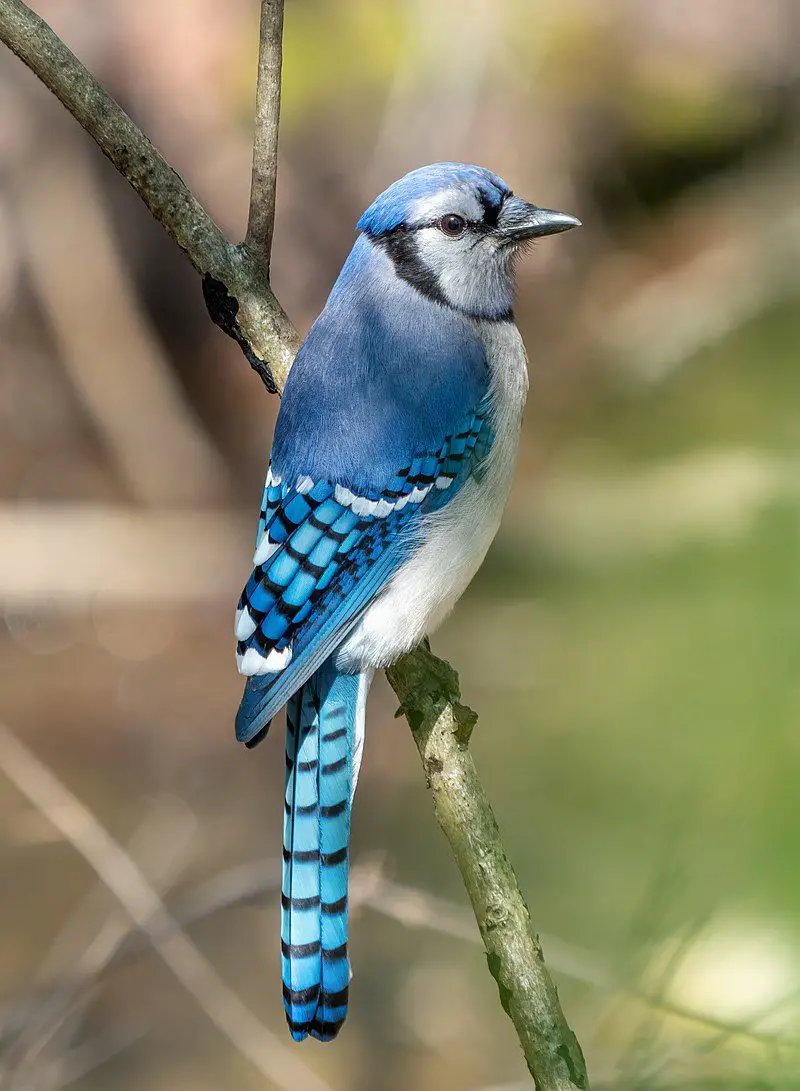
Cyanocitta is a bird that belongs to a family of birds called Corvidae. The Corvidae family includes crows, jays, and magpies.
This family is known for its intelligent and social birds. The genus Cyanocitta was established by a man named Hugh Edwin Strickland in 1845. He identified a group of birds with similar characteristics and named them Cyanocitta.
A genus is a classification category in taxonomy that groups species with common characteristics. The name Cyanocitta has an interesting origin. It is derived from two Greek words – kuanos and kitta.
Kuanos meguanosark blue” in Greek, while kitta meakittenay.” So, when these words are combined, Cyanocitta can be understood to mean “dark blue jay.”This name fits the birds in this genus because they have a distinctive dark blue coloration.
The combination of blue feathers and their jay-like features gives them their unique appearance. Cyanocitta is not a specific bird species but a group containing several different species. These species share specific characteristics that set them apart from other birds.
They are known for their intelligence.
| Kingdom | Animalia |
| Phylum | Chordata |
| Clade | Dinosauria |
| Class | Aves |
| Order | Passeriformes |
| Family | Corvidae |
| Genus | Cyanocitta |
32. American Crow
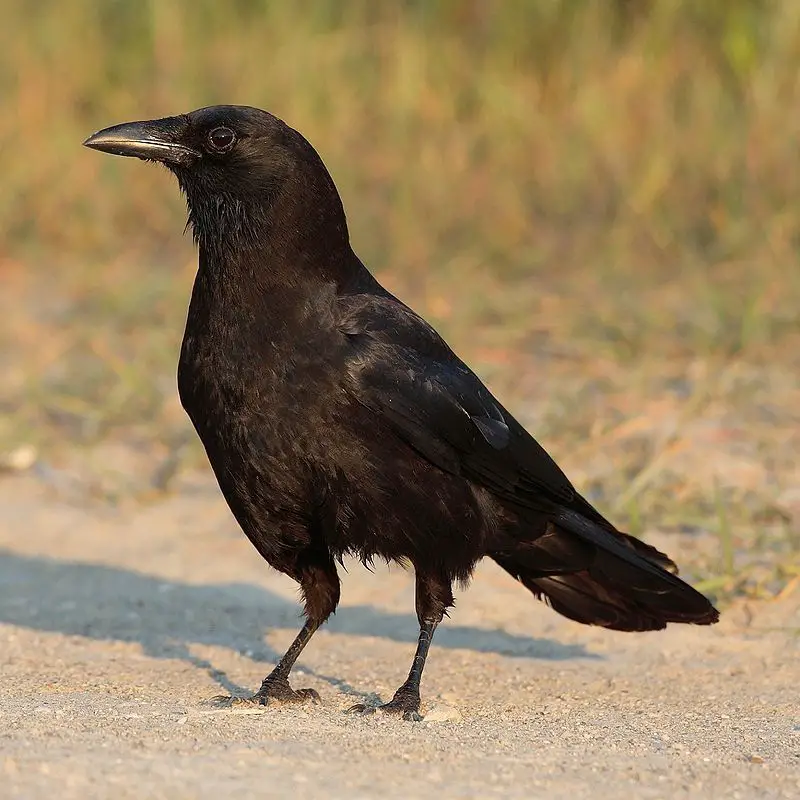
The American crow is a type of bird that belongs to the Corvidae family. This family includes other birds like ravens and jays. The American crow is quite extensive and is known as a passerine bird, which means it has feet that are adapted for perching on branches.
You can find American crows in many parts of North America. They are very common birds, so you might have seen them in your neighborhood. They have adapted well to different environments and can be found in urban areas, forests, and open fields.
Interestingly, American crows are similar to two other crows found in different parts of the world. These are the carrion crow and the hooded crow found in Europe and Asia.
Despite being from different continents, these three crows occupy the same ecological niche. An ecological niche refers to the role a species plays in its environment. In this case, the American crow, carrion crow, and hooded crow have similar behaviors and habits.
They are opportunistic feeders, meaning they eat a wide range of things like insects, fruits, small animals, and even garbage. They also play essential roles in controlling populations of certain pests and scavenging.
| Kingdom | Animalia |
| Phylum | Chordata |
| Clade | Dinosauria |
| Class | Aves |
| Order | Passeriformes |
| Family | Corvidae |
| Genus | Corvus |
| Species | C. brachyrhynchos |
33. Common Grackle
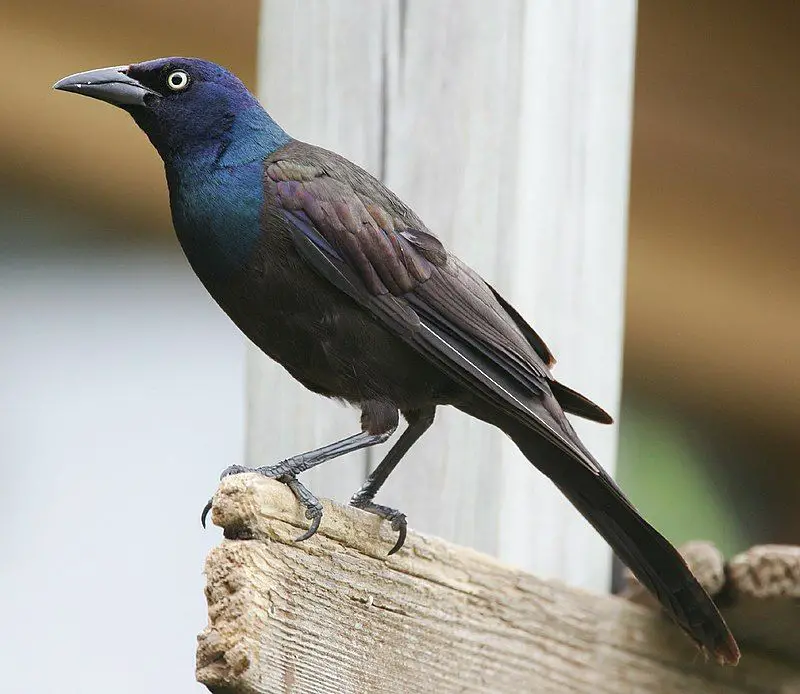
The common grackle is a type of bird found in many parts of North America. It was first identified and described by a scientist named Carl Linnaeus in 1758. This bird belongs to a family of birds known as icterids.
One exciting thing about the common grackle is that it has three different subspecies. This means there are slight variations in appearance among the various groups of these birds. When an adult common grackle is fully grown, it has certain distinct features.
For example, it has a long bill that is dark in color. The bird uses this bill to catch and eat its food. The common grackle also has pale yellow eyes, which add to its unique appearance. Another noticeable characteristic of the adult common grackle is its long tail.
This tail is an essential part of the bird’s body, as it helps with balance and maneuverability during flight. It is worth noting that the common grackle is a reasonably large bird compared to some other species.
Its size contributes to its visibility and makes it easier to spot in its natural habitat. The common grackle is an exciting bird species with distinct physical traits. It’s large numbers across the North.
| Kingdom | Animalia |
| Phylum | Chordata |
| Clade | Dinosauria |
| Class | Aves |
| Order | Passeriformes |
| Family | Icteridae |
| Genus | Quiscalus |
| Species | Q. quiscula |
34. Northern Flicker
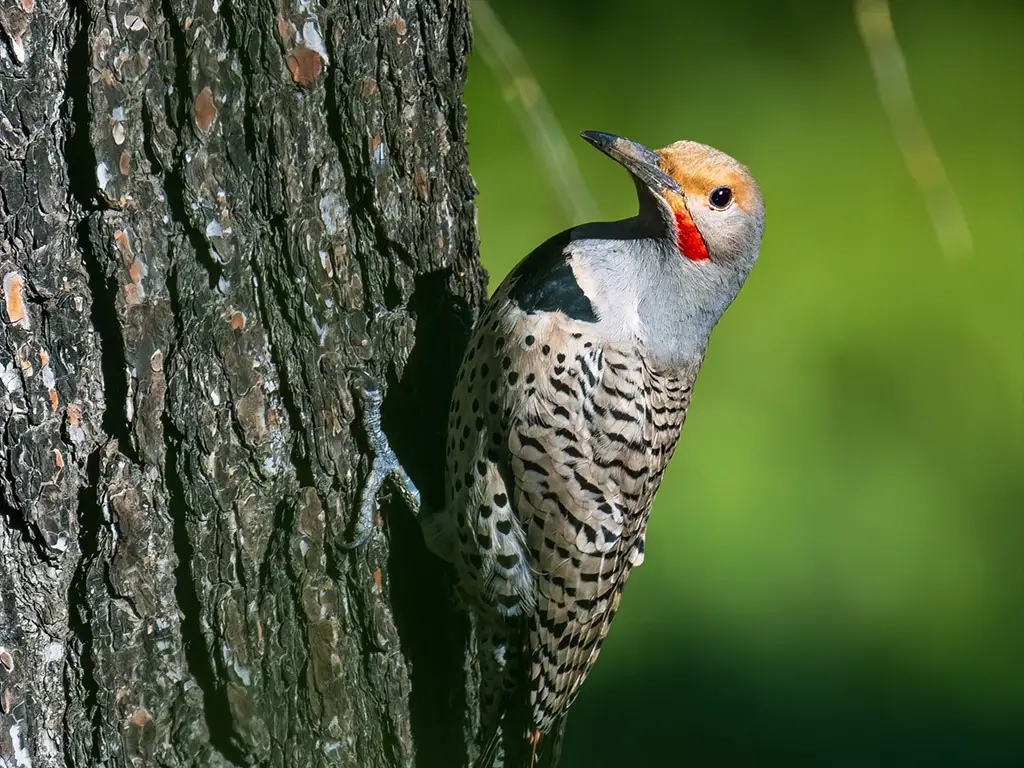
The northern flicker is a type of bird that belongs to the woodpecker family. It is not a very large bird but also not too small. The northern flicker can be found in many parts of North America.
It is also native to some areas in Central America, such as Cuba and the Cayman Islands. One exciting thing about the northern flicker is that it is one of the few woodpecker species that migrate.
Migration means these birds travel from one place to another during different seasons. They do this to find food and suitable habitats.
The northern flicker migrates to different regions depending on the time of year. During the breeding season, which is usually in the spring or summer, the northern flicker can be found in many parts of North America.
They build their nests in trees and use their strong beaks to create holes in the wood. These holes are called cavities and serve as their homes. Northern flickers are known for their distinctive markings.
They have a brown body with black spots, and their wings have a white patch easily visible when flying. Another unique feature is the red or yellow coloration on the underside of their wings and tail, which can be seen when they.
| Kingdom | Animalia |
| Phylum | Chordata |
| Clade | Dinosauria |
| Class | Aves |
| Order | Piciformes |
| Family | Picidae |
| Genus | Colaptes |
| Species | C. auratus |
35. Bald Eagle
The bald eagle is a type of bird that lives in North America. It is considered a bird of prey, which means it hunts and feeds on other animals. This majestic bird is also known as a sea eagle. There are two known subspecies of the bald eagle.
Subspecies are variations of a species that have slightly different characteristics but can still interbreed. These subspecies of the bald eagle might have some differences in appearance or behavior. The bald eagle is closely related to another bird called the white-tailed eagle.
These two birds form a species pair, which means they are similar and occupy similar ecological niches.
The white-tailed eagle is found in the Palearctic region, which includes Europe, Asia, and Africa. Occupying the same niche means that the bald eagle and the white-tailed eagle have similar roles in their respective ecosystems.
They both have adaptations that help them survive and thrive in their environments.
They might compete for similar food sources or have similar hunting strategies. In the Palearctic region, where the white-tailed eagle is found, it fulfills an ecological role similar to that of the bald eagle in North America.
This means both species have evolved to fill a specific niche or role in their habitats.
| Kingdom | Animalia |
| Phylum | Chordata |
| Clade | Dinosauria |
| Class | Aves |
| Order | Accipitriformes |
| Family | Accipitridae |
| Genus | Haliaeetus |
| Species | H. leucocephalus |
36. American Kestrel
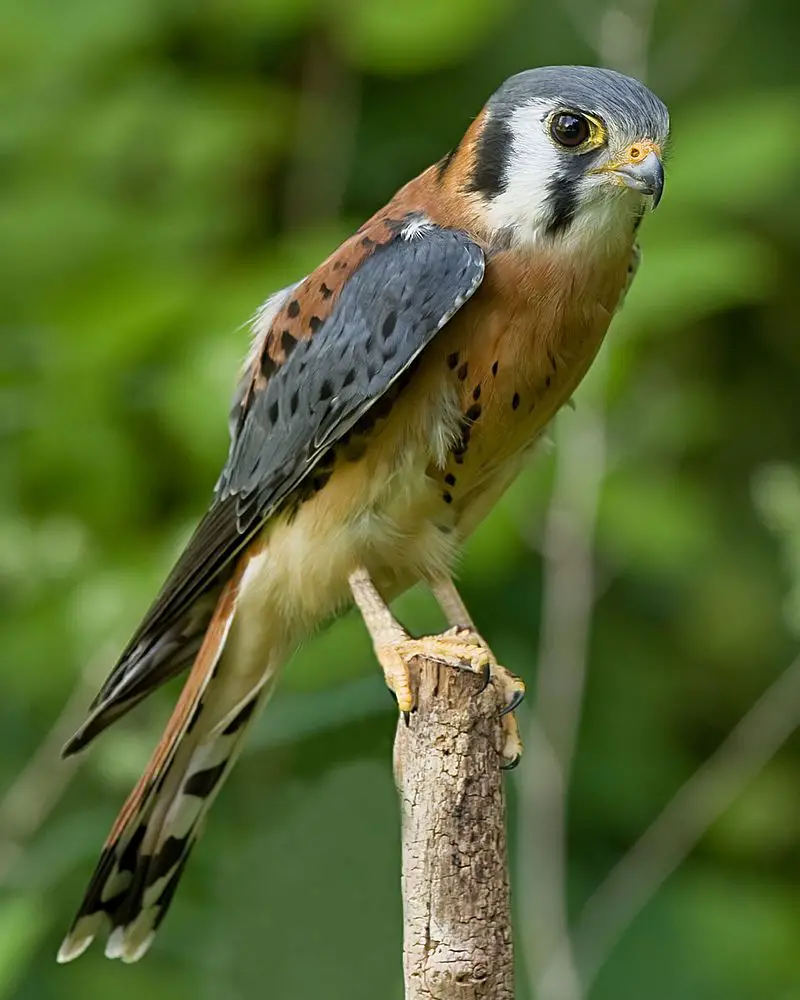
The American kestrel is a type of falcon that can also be known as the sparrow hawk. It is found in North America and is the region’s smallest and most common falcon. The size of the American kestrel can vary depending on the subspecies and the sex of the bird.
Generally, there is a two-to-one range in size between different individuals. When it comes to size, the American kestrel can range from being as small as a blue jay to as large as a mourning dove.
This means some individuals can weigh as much as a blue jay, while others can be as heavy as a mourning dove. The variation in size within the American kestrel population can be attributed to differences in subspecies and between males and females.
This means that females may generally be more significant than males, and different subspecies may have different average sizes. Interestingly, despite this size variation, the American kestrel remains the smallest falcon in North America.
This indicates that even the most prominent individuals of this species are still relatively small compared to other falcons found in the region. In conclusion, the American kestrel is also known as the sparrow.
| Kingdom | Animalia |
| Phylum | Chordata |
| Clade | Dinosauria |
| Class | Aves |
| Order | Falconiformes |
| Family | Falconidae |
| Genus | Falco |
| Species | F. sparverius |
37. Wild Turkey
The wild turkey is a type of bird that can be found in North America. It is considered an upland game bird because it lives in the upland areas of the continent.
The wild turkey is one of two species that still exist today. Belonging to the order Galliformes, the wild turkey is the heaviest member of this group. This means that the wild turkey weighs the most among all the birds in the Galliformes order.
It has a large and robust body, which contributes to its heavy weight. Interestingly, the wild turkey is also the ancestor of the domestic turkey we commonly see today. The domestic turkey originated from a subspecies of wild turkey that lived in southern Mexico.
Over time, humans selectively bred and domesticated these wild turkeys, resulting in the domesticated turkeys we now encounter. This means that the domestic turkey we often consume during special occasions or holidays, such as Thanksgiving, has its roots in the wild turkey.
Through selective breeding and domestication, humans have transformed the wild turkey into a bird suitable for farming and consumption. The wild turkey is a fascinating bird that has played a significant role in developing domestic turkey.
Its existence as a native.
| Kingdom | Animalia |
| Phylum | Chordata |
| Clade | Dinosauria |
| Class | Aves |
| Order | Galliformes |
| Family | Phasianidae |
| Genus | Meleagris |
| Species | M. gallopavo |
38. Brown-Headed Cowbird
The brown-headed cowbird is a bird species found in temperate and subtropical regions of North America. It is known for its behavior as a brood parasite, meaning it lays its eggs in the nests of other bird species.
This behavior is obligatory for the brown-headed cowbird, which means it relies on other birds to raise its young. The brown-headed cowbird is a small bird with a brown head and dark body.
It is commonly found in the southern parts of its range throughout the year, where it remains a permanent resident.
However, the birds from the northern regions migrate to the southern United States and Mexico during the winter season.
The migration of the northern brown-headed cowbirds occurs because the colder conditions in their northern habitats make it challenging to find sufficient food during the winter months.
Traveling to the southern regions, where the climate is milder, and food resources are more abundant, increases their chances of survival. The migration typically takes place in a southward direction, starting around the onset of winter.
These birds undertake a long journey, often flying for miles to reach their wintering grounds. They remain in these warmer regions until spring, which is around March or April, once the winter season ends.
| Kingdom | Animalia |
| Phylum | Chordata |
| Clade | Dinosauria |
| Class | Aves |
| Order | Passeriformes |
| Family | Icteridae |
| Genus | Molothrus |
| Species | M. ater |
39. Eastern Phoebe
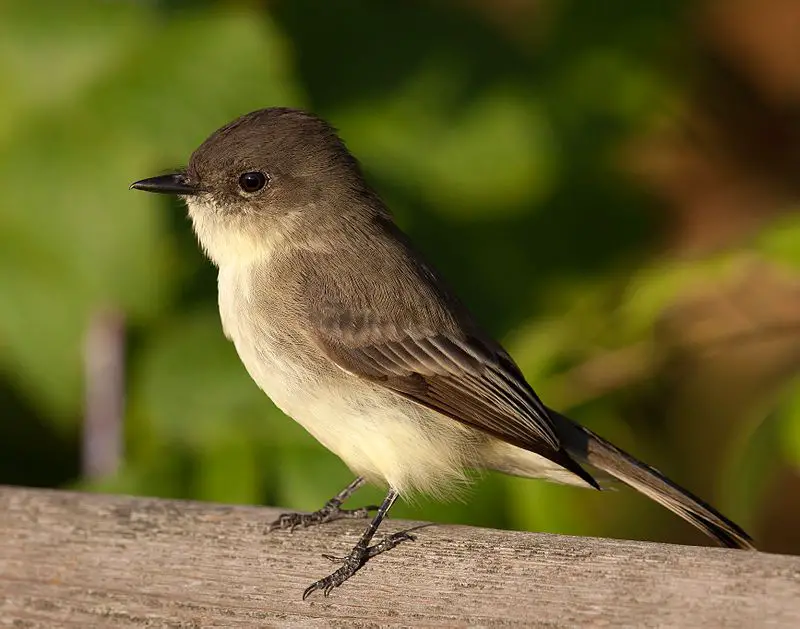
The eastern phoebe is a small bird that belongs to the passerine family. This family includes birds with feet specially adapted for perching, singing, and eating seeds or insects.
The eastern phoebe is one of these birds. The scientific name of the east phoebe is Sayornis. This name is derived from the specific part of Charles Lucien Bonaparte’s name for Say’s phoebe, another closely related bird species.
Charles Lucien Bonaparte, a French ornithologist, discovered and named several bird species. The specific name for Say’s phoebe, Muscicapa saya, was taken by Bonaparte and combined with the Ancient Greek word “ornis,” which means “bird.”
This combination resulted in the genus name Sayornis for the eastern phoebe. The genus name is essential in scientific classification because it helps scientists categorize and identify different species.
Using a standardized naming system, scientists can communicate more effectively about specific birds and their characteristics. In this case, the genus name Sayornis indicates that the eastern phoebe is closely related to Say’s phoebe.
It helps scientists understand the evolutionary relationships between these two species.
| Kingdom | Animalia |
| Phylum | Chordata |
| Clade | Dinosauria |
| Class | Aves |
| Order | Passeriformes |
| Family | Tyrannidae |
| Genus | Sayornis |
| Species | S. phoebe |
40. Barred Owl
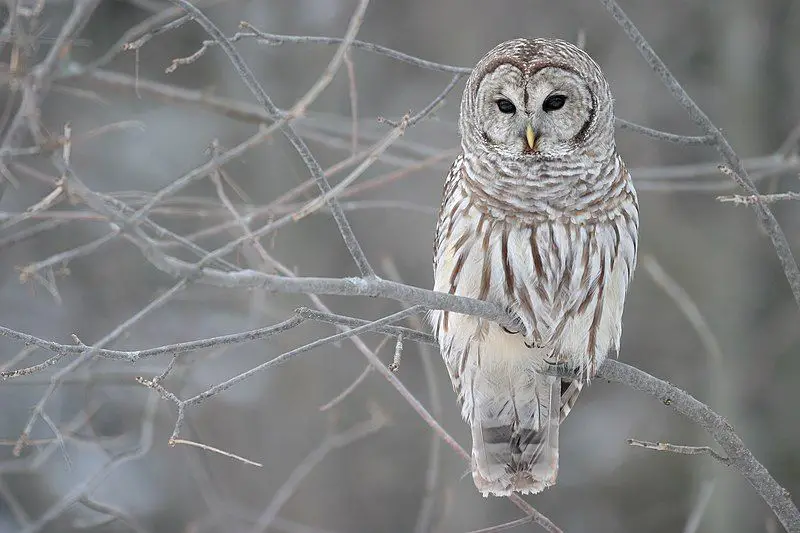
The barred owl is a type of owl found in North America. It is sometimes called the northern barred owl, striped owl, hoot owl, or eight-hooter owl.
This owl is quite large compared to other owls. It belongs to a family of owls called Strigidae, known as true owls. The barred owl belongs explicitly to the genus Strix.
The name of the family, Strigidae, comes from the genus Strix. Linnaean taxonomy is a system of naming and classifying organisms created by Carl Linnaeus, a Swedish botanist.
This system organizes living organisms into different categories based on their characteristics. The barred owl’s scientific name is Strix varia. The genus name comes first in Linnaean taxonomy, followed by the species name.
So, for the barred owl, Strix is the genus, and varia is the species.
This helps scientists and researchers identify and study different species. The barred owl is known for its distinctive call, which sounds like “who-cooks-for-you, who-cooks-for-you-all.” This call is often heard at night, which is why it is sometimes referred to as a hoot owl.
| Kingdom | Animalia |
| Phylum | Chordata |
| Clade | Dinosauria |
| Class | Aves |
| Order | Strigiformes |
| Family | Strigidae |
| Genus | Strix |
| Species | S. varia |
41. Osprey
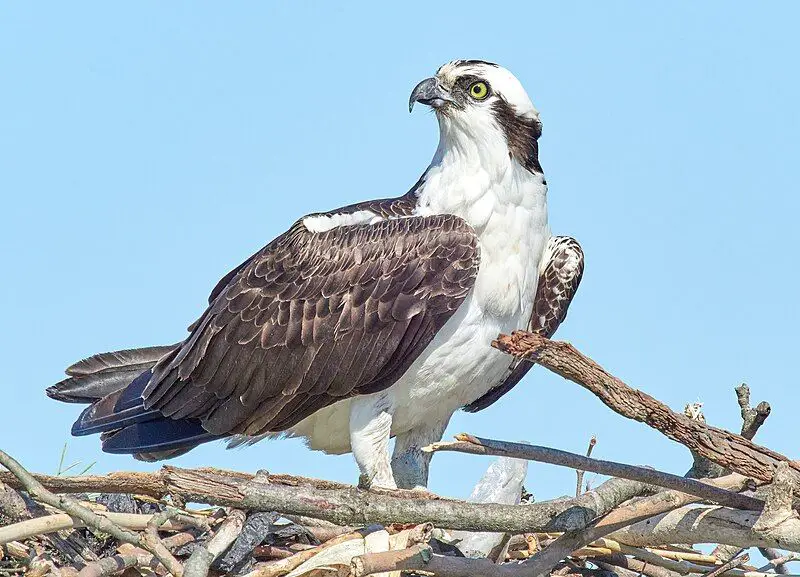
The osprey is a bird known by different names, such as sea hawk, river hawk, and fish hawk. It is a bird of prey that hunts and eats fish and is active during the daytime, which means it is diurnal.
The osprey can be found in various parts of the world, as it has a cosmopolitan range. In terms of size, the osprey is considered to be a large bird. It can grow to be more than 60 cm long, and its wingspan can reach 180 cm.
This makes it impressive when it takes flight and soars through the sky. In terms of appearance, the osprey has distinct coloring. The upper parts of its body are brown, which helps it blend in with its surroundings when perched on trees or other structures.
However, its head and underparts are predominantly greyish. This coloring may provide camouflage when the osprey is near bodies of water, where it hunts for fish. Overall, the osprey is a fascinating bird with unique characteristics.
Its ability to hunt fish, its large size, and its distinct coloring make it a remarkable species to observe in its natural habitat.
| Kingdom | Animalia |
| Phylum | Chordata |
| Clade | Dinosauria |
| Class | Aves |
| Order | Accipitriformes |
| Family | Pandionidae |
| Genus | Pandion |
| Species | P. haliaetus |
42. Red-Tailed Hawk
The red-tailed hawk is a type of bird known as a bird of prey. It is found in many different parts of North America. It breeds in various locations, from the interior of Alaska and northern Canada to Panama and the West Indies.
This means you can find red-tailed hawks in many places throughout North America. The red-tailed hawk belongs to a group of birds called the genus Buteo. This genus includes many other species of hawks.
However, the red-tailed hawk is one of the most common members of this group, both in North America and worldwide.
This means you will likely encounter a red-tailed hawk more often than other types of hawks within the Buteo genus. The red-tailed hawk is known for its distinctive red tail, which is where it gets its name from.
This feature helps to distinguish it from other types of hawks. However, it is essential to note that not all red-tailed hawks have red tails.
Juvenile red-tailed hawks have brown tails, which only turn red as they mature. Red-tailed hawks are known for their impressive hunting skills. As birds of prey, they primarily.
| Kingdom | Animalia |
| Phylum | Chordata |
| Clade | Dinosauria |
| Class | Aves |
| Order | Accipitriformes |
| Family | Accipitridae |
| Genus | Buteo |
| Species | B. jamaicensis |
43. Sharp-Shinned Hawk
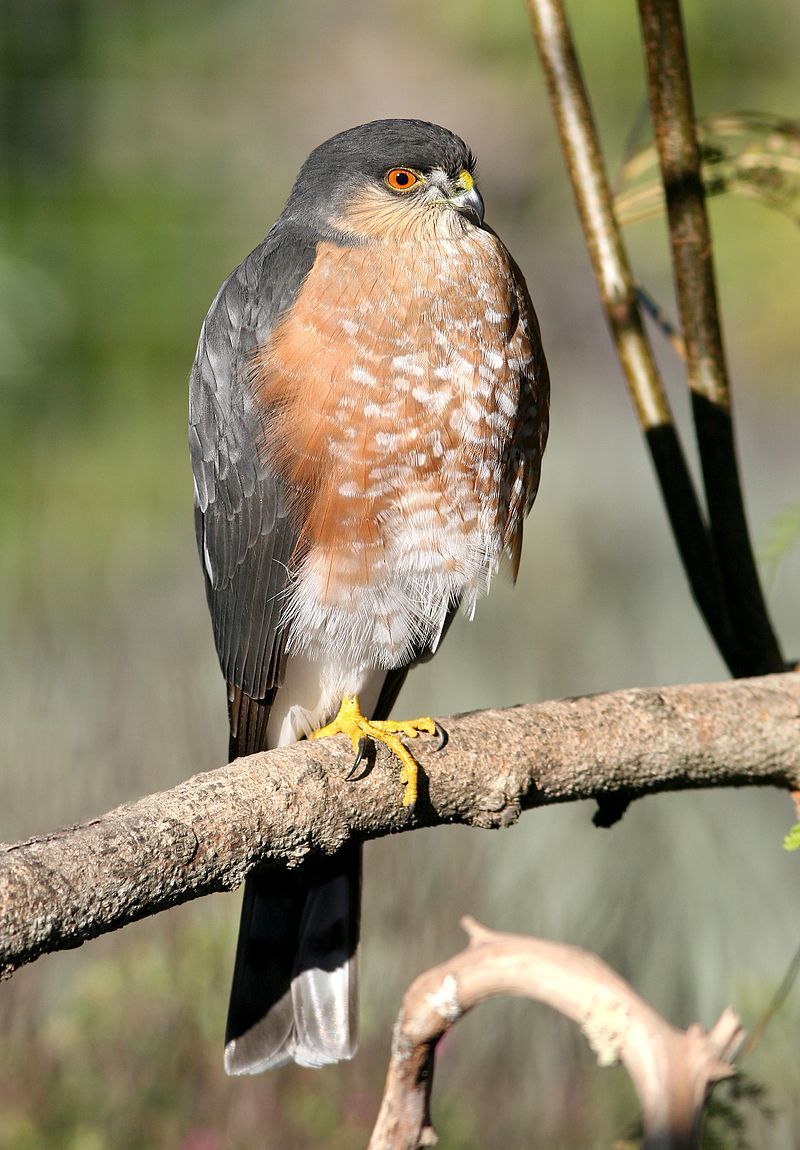
The sharp-shinned hawk, also known as a sharpie, is a small hawk type. The males of this species are the smallest hawks found in both the United States and Canada.
However, it’s worth noting that the sharp-shinned hawk is still larger than certain Neotropical species, such as the tiny hawk. This particular species of hawk is commonly referred to as a sharpie due to its sharp features and small size.
Although it is small compared to other hawks, it is essential to understand that it is still larger than certain types of hawks found in the Neotropics, a region of the Americas encompassing Central and South America.
The sharp-shinned hawk’s size is noteworthy because it is the smallest species in the United States and Canada.
This means that the sharp-shinned hawk stands out for its diminutive size compared to other hawks that inhabit these regions.
Furthermore, it is interesting to consider that despite being small in North American hawks, the sharp-shinned hawk is still more prominent on average than some Neotropical species, such as the tiny hawk.
This suggests that while the sharp-shinned hawk may be small relative to.
| Kingdom | Animalia |
| Phylum | Chordata |
| Clade | Dinosauria |
| Class | Aves |
| Order | Accipitriformes |
| Family | Accipitridae |
| Genus | Accipiter |
| Species | A. striatus |
44. Rock Dove
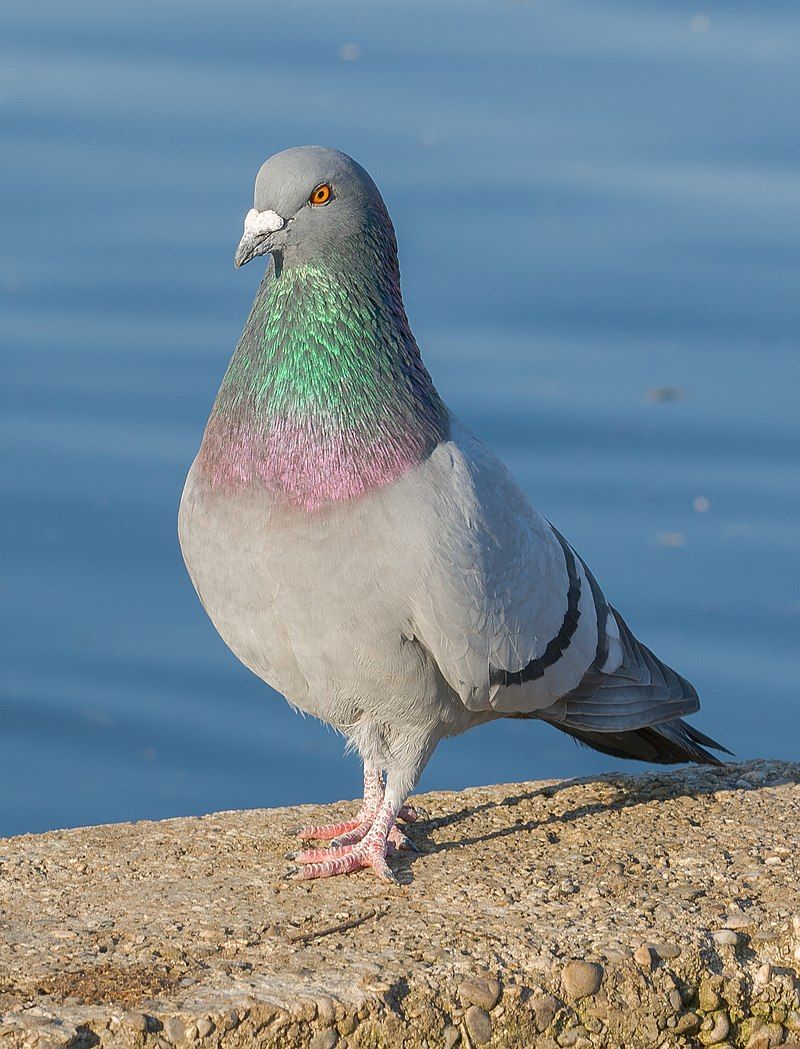
The rock dove, also known as the rock pigeon or common pigeon, belongs to the bird family Columbidae. Many people commonly refer to it as simply the “pigeon.” The domestic pigeon is a descendant of this species.
When domestic pigeons escape captivity, they have contributed to the rise in feral pigeon populations worldwide. The rock dove, or rock pigeon, is a type of bird that belongs to the Columbidae family. It is often called a pigeon in everyday language.
This species has given rise to the domestic pigeon through generations of breeding. Domestic pigeons are descended from the rock dove species.
Over time, humans have selectively bred these birds for various traits, developing different pigeon breeds.
Domestic pigeons are often kept as pets or used in pigeon racing and other sports. However, sometimes domestic pigeons escape or are released into the wild.
These pigeons, adapted to living with humans rather than in the wild, are known as feral pigeons.
Feral pigeon populations have increased globally due to the presence of escaped domestic pigeons. Escaped domestic pigeons can interbreed with feral pigeons, further contributing to their population growth.
| Kingdom | Animalia |
| Phylum | Chordata |
| Clade | Dinosauria |
| Class | Aves |
| Order | Columbiformes |
| Family | Columbidae |
| Genus | Columba |
| Species | C. livia |
45. Red-Breasted Nuthatch
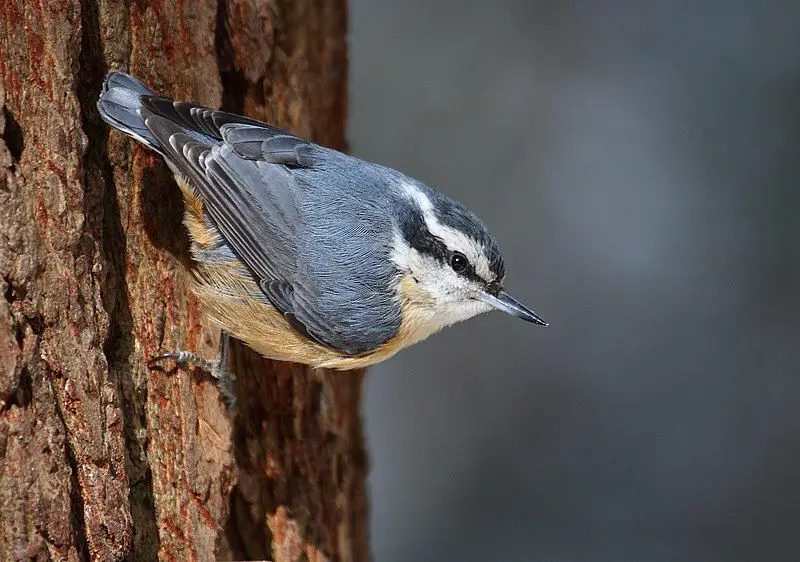
The red-breasted nuthatch is a small bird known for its beautiful appearance and unique characteristics. It has blue-grey feathers on its upper body and cinnamon-colored feathers on its underparts.
This combination of colors creates a striking contrast. Looking closely at the red-breasted nuthatch, you will notice a white throat and face. These white areas provide a stark contrast against the rest of its body.
Additionally, a distinct black stripe runs through its eyes, giving it a charming and distinctive look. Another notable feature of the red-breasted nuthatch is its straight grey bill.
This bill is perfectly shaped for its feeding habits, allowing it to crack open seeds and nuts easily. The bird’s bill is functional and adds to its overall appearance. One of the most striking features of the red-breasted nuthatch is its black crown.
This black area on its head gives the bird a regal and elegant look. Combined with its blue-grey and cinnamon colors, the black crown adds a touch of sophistication to its appearance. Apart from its visual characteristics, the red-breasted nuthatch has a unique call.
Described as a tin trumpet, its call is high-pitched.
| Kingdom | Animalia |
| Phylum | Chordata |
| Clade | Dinosauria |
| Class | Aves |
| Order | Passeriformes |
| Family | Sittidae |
| Genus | Sitta |
| Species | S. canadensis |
46. Bufflehead
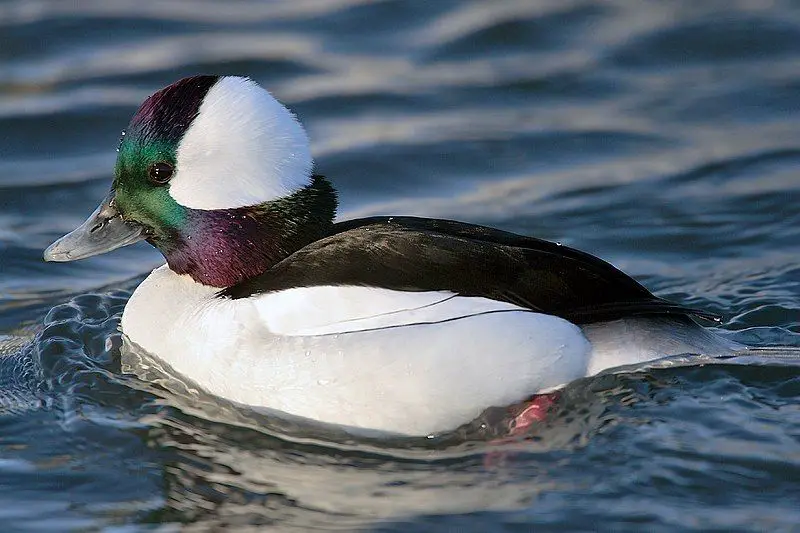
The paragraph discusses the bufflehead, a small sea duck from Bucephala. This genus also includes other ducks known as goldeneyes.
Carl Linnaeus, a renowned Swedish scientist, first identified and described the bufflehead in his influential work Systema Naturae. Linnaeus published the 10th edition of this book in 1758, where he classified various species of plants and animals.
In this edition, he named the bufflehead Anas albeola, the scientific name for this species.
| Kingdom | Animalia |
| Phylum | Chordata |
| Clade | Dinosauria |
| Class | Aves |
| Order | Anseriformes |
| Family | Anatidae |
| Genus | Bucephala |
| Species | B. albeola |
47. Snowy Owl
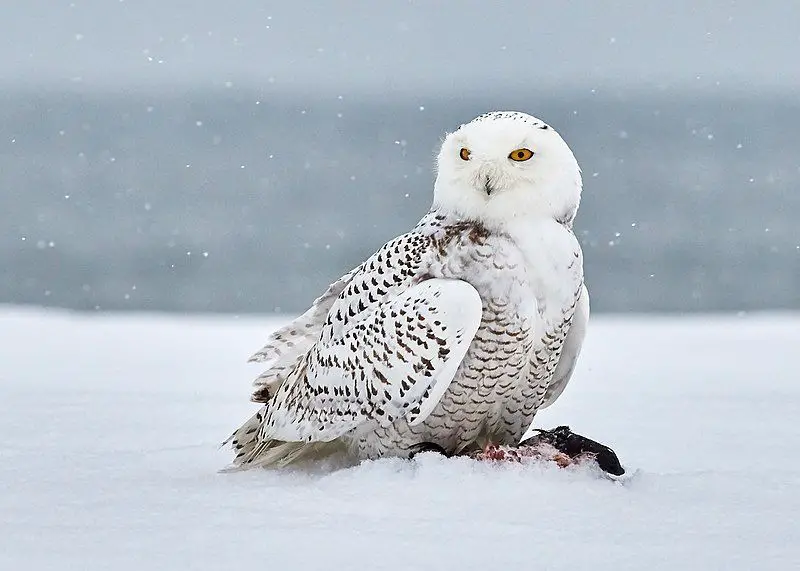
The snowy owl is a type of owl known by other names, such as polar, white, and Arctic owl. It belongs to the true owl family and is characterized by its large size and white feathers.
These owls can be found in both North America and the Palearctic regions, specifically in the Arctic areas. Snowy owls are well adapted to their harsh Arctic environments.
They have evolved to blend in with the snowy landscapes, which helps them remain camouflaged and hidden from predators.
Their white feathers act as a protective cover, allowing them to hunt and survive in their habitat. One interesting fact about snowy owls is that they are predominantly found in the tundra regions.
The tundra is a cold and treeless biome characterized by low temperatures and short summers. This environment provides ideal conditions for the snowy owl’s breeding. During the breeding season, snowy owls build their nests on the ground.
They use the tundra’s vegetation and materials like feathers and moss to construct their nests. This nesting behavior is unique among owls, as most other owl species prefer to nest in trees. Snowy owls feed primarily on small mammals, such as lemmings and voles.
| Kingdom | Animalia |
| Phylum | Chordata |
| Clade | Dinosauria |
| Class | Aves |
| Order | Strigiformes |
| Family | Strigidae |
| Genus | Bubo |
| Species | B. scandiacus |
48. Ruby-Throated Hummingbird
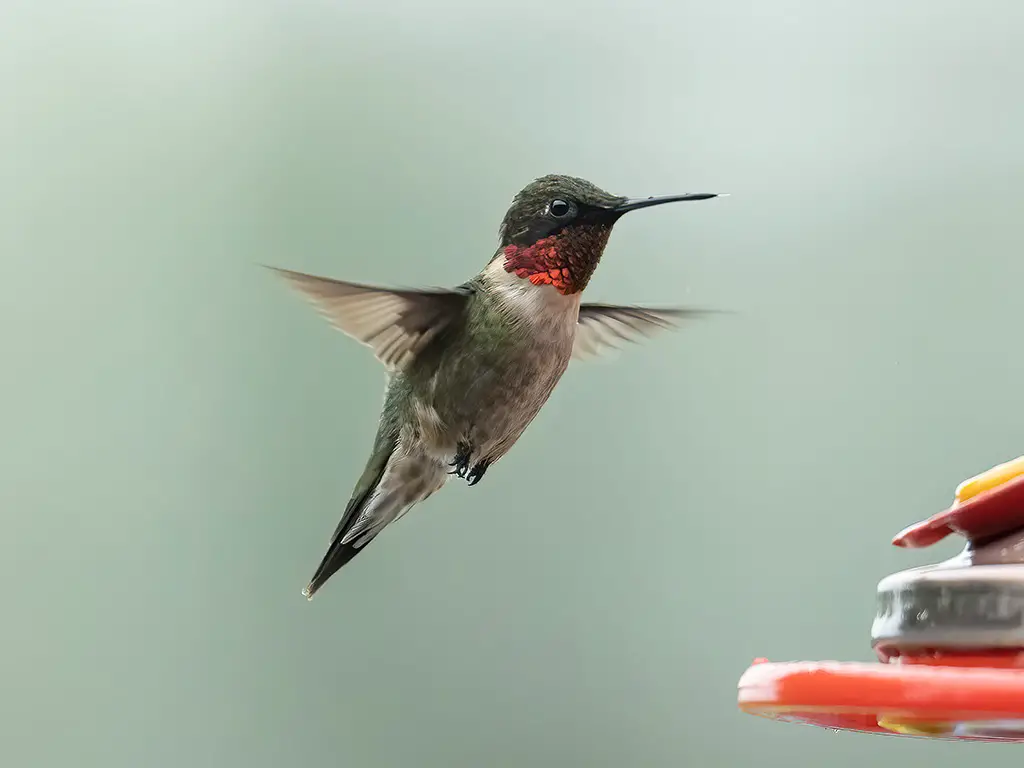
The ruby-throated hummingbird is a type of hummingbird that has a bright red throat. This species is known for its unique migration pattern. These hummingbirds can be found in Central America, Mexico, and Florida during the winter months.
They choose these warmer regions because they provide a more suitable climate for survival. However, the ruby-throated hummingbird embarks on an incredible journey when the summer season arrives.
They migrate to Canada and other parts of Eastern North America to breed.
This long-distance migration allows them to take advantage of the abundant resources available in these areas during the summer months. The reason behind this seasonal migration is quite fascinating.
In Central America, Mexico, and Florida, the ruby-throated hummingbirds find a variety of nectar-producing flowers that provide them with a sufficient food source.
These flowers bloom during the winter, ensuring the hummingbirds have enough energy to survive. But as the seasons shift and the temperatures rise, the flowers in these regions begin to wither away.
This scarcity of food prompts the hummingbirds to undertake their impressive journey northward. They instinctively know that Canada and Eastern North America offer abundant nectar-producing flowers during the summer, which is ideal for them.
| Kingdom | Animalia |
| Phylum | Chordata |
| Clade | Strisores |
| Class | Aves |
| Order | Apodiformes |
| Family | Trochilidae |
| Genus | Archilochus |
| Species | A. colubris |
49. Common Eider
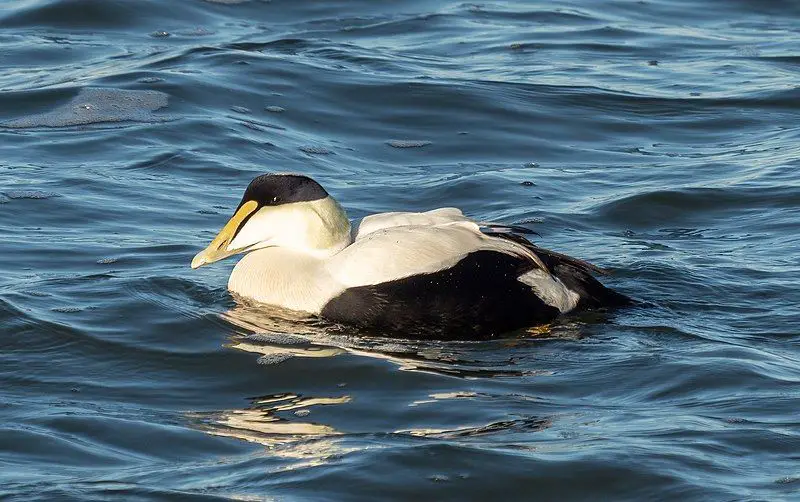
The common eider is a type of sea duck that can be found in various regions around the world. It is sometimes called St. Cuthbert’s duck or Cuddy’s duck.
These ducks are known for their large size and are commonly found along the northern coasts of Europe, North America, and eastern Siberia. One interesting fact about the common eider is its distribution.
These ducks have established their presence in different parts of the world. They can be seen along the coasts of Europe, including countries like Norway, Sweden, and Iceland.
They are also found along the coasts of North America, from Alaska to Maine, and even in eastern Siberia. The common eider’s ability to adapt to various climates and environments is impressive.
They are well-suited to life in coastal areas, especially those with colder temperatures.
This adaptability allows them to thrive in regions with different weather conditions and ecosystems. One of the reasons for the widespread distribution of common eiders is their preference for coastal habitats.
They are often found near rocky shores, sandy beaches, and offshore islands. These ducks are capable of navigating both saltwater and freshwater environments, making them versatile in their choice of habitat.
| Kingdom | Animalia |
| Phylum | Chordata |
| Clade | Dinosauria |
| Class | Aves |
| Order | Anseriformes |
| Family | Anatidae |
| Genus | Somateria |
| Species | S. mollissima |
Conclusion
Winter birds in Massachusetts play a vital role in the ecosystem and bring unique beauty and diversity to the state’s landscape during the colder months.
Their ability to adapt to harsh conditions and find food sources demonstrates their resilience and resourcefulness. By providing habitat and food sources for these birds, individuals and communities can contribute to their conservation efforts.
Winter birdwatching also offers a rewarding and educational experience for nature enthusiasts, showcasing the importance of preserving and protecting these species and their habitats.
Overall, winter birds in Massachusetts are a cherished part of the state’s natural heritage, and their conservation is crucial for maintaining the ecological balance and biodiversity in the region.